Your Norway Trip Itinerary: A 14-Day Breakdown

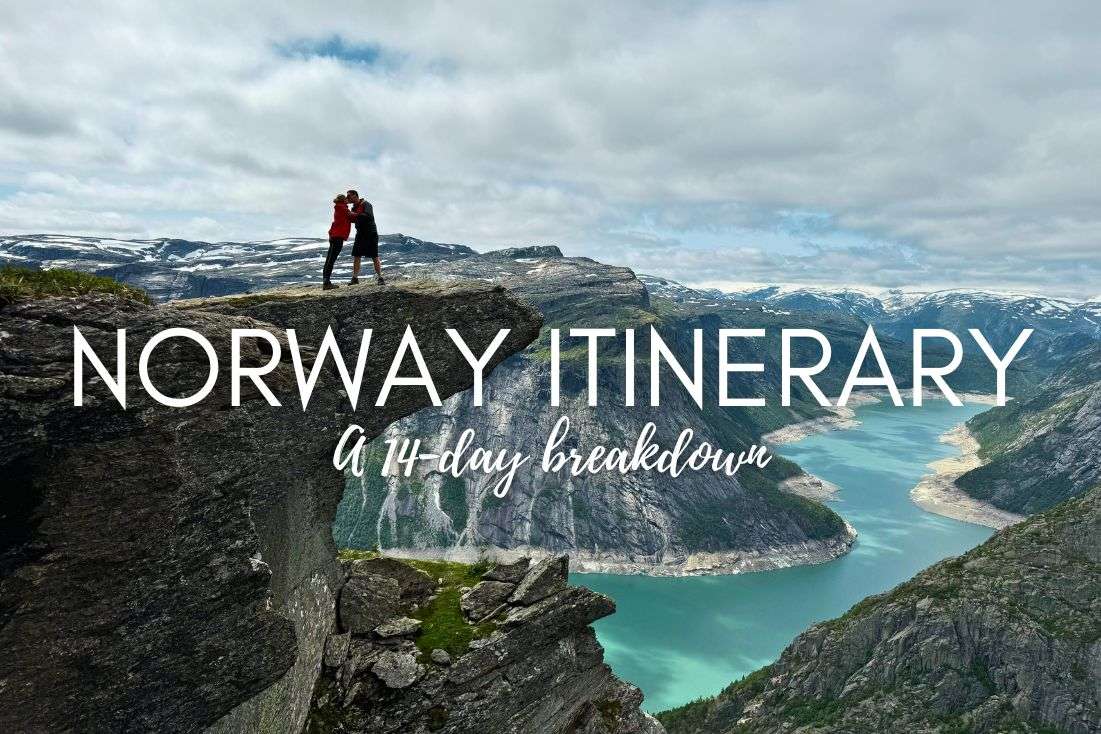
When my girlfriend and I decided to tackle Norway, we didn’t want some half-hearted time of sitting on a cruise ship all day, just waving at the fjords. Nope—hiking is very much my game, so this is a very active Norway trip itinerary.
Think rugged mountains, glacier treks, and trails so beautiful they make you wonder why you ever wasted time in the gym instead of taking advantage of the great outdoors. Not to boast too much, but I wouldn’t change a thing about this 2-week plan. This was my Norway itinerary, and now it’s yours!
Now, I won’t lie—there’s a lot of driving involved, but driving in Norway is basically a pastime in and of itself. The roads wind through incredible landscapes with glaciers on one side and plunging fjords on the other. Honestly, the journeys between stops were as memorable as the destinations themselves.
This itinerary hits all the best places to visit in Norway: charming villages, iconic hikes, and quirky cities. It’s equal parts exhausting and exciting, but that’s the magic of Norway—it demands effort but rewards you tenfold.
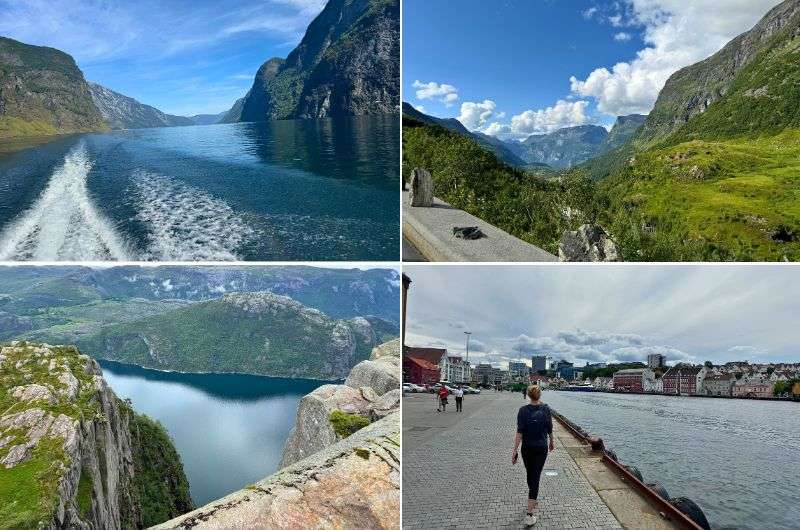
Get ready for your best 14 days in Norway! And there's a lot to see
Lace up your (sturdy, waterproof, grippy) boots, start your engines, and prepare for 14 days of Norwegian mega-adventure!
Learn even more about Norway right here...
The best 2-week Norway itinerary: outline
- Day 0: How to get to Norway
- Day 1: Stavanger and Lysefjord
- Day 2: Stavanger and Pulpit Rock hike
- Day 3: Kjerag/Kjeragbolten hike
- Day 4: Folgefonna glacier hike
- Day 5: Buarbreen glacier and Nykkjesøyfossen hikes
- Day 6: Trolltunga hike
- Day 7: Flåm
- Day 8: Aurlandsfjord
- Day 9: Jostedalsbreen National Park
- Day 10: Traveling from Stryn to Ålesund
- Day 11: Ålesund
- Day 12: Trollstigen and Geirangerfjord
- Day 13: Sognefjellet and Vettisfossen
- Day 14: Besseggen Ridge hike
Sometimes, all you need to do is take the first step... I've filtered out the best hotels in Norway for you
Save it for yourself to come back to later, or share with your friends on social media!
Your 2-week Norway itinerary: map
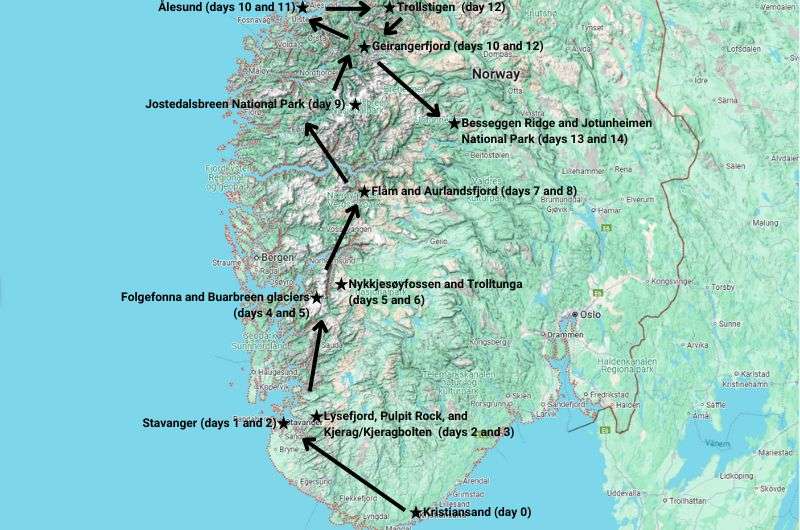
Route map of my 14-day Norway itinerary

My 10 quick tips for spending 14 days in Norway
- Pack for every season, all at once. Norway's countryside goes through mood swings like a diva. Warm sunshine at noon, rain by 2 pm, and snow if you're really lucky. Layers are your best friends.
- Check webcams before you set out. If you want to avoid the disappointment of fog ruining your epic view, online camera-views are your crystal ball.
- Prepare yourself mentally for a lot of driving. The average speed is around 70 km/h (43 mi/h), and people stick to it strictly. Norwegian drivers can be a bit rude, rarely yielding or making room, and they drive some hella flashy cars.
- Ferries are your friends. They’re efficient, frequent, and surprisingly chill. Register your car on ferrypay.no and enjoy the ride without hassle.
- Tunnel vision—literally. Prepare for Norway’s epic love affair with tunnels. You’ll drive through enough to feel like a mole, but hey, they cut travel time and often pop out into stunning scenes. However, you have to pay a toll on some of them; follow the instructions to register your car at epass24.com. If you’re driving a rental car, the car rental company should bill you.
- Be early, beat the rain. Morning excursions are golden—crisp air, empty trails, and usually dry weather.
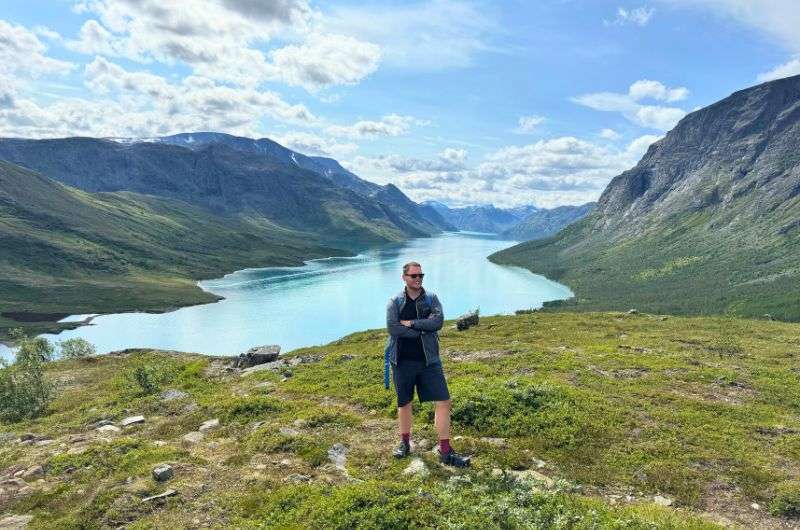
Don’t worry, I planned your 14 days in Norway
- Budget and plan ahead for parking. Parking in the Norwegian countryside can be shockingly expensive and often limited near popular trails or viewpoints. Use official parking lots (even if pricey) to avoid fines and always check if payment is app-based—many spots don’t take cash!
- Gear up. Make sure you have sturdy, waterproof hiking boots, a rain jacket, and a reliable backpack. Bonus points for bringing trekking poles and a reusable water bottle. Norway’s tap water is fresher than most bottled brands!
- Costs are bearable. Overall, Norway is about twice as pricey as other Western European countries, but it’s not outrageous. You can manage—I thought Israel was way worse!
- Hotels aren’t amazing and the less said about restaurant service, the better. Lower your expectations. Overall, the best place that I stayed at on this itinerary was probably Vangsgaarden Gjestgiveri in Aurland.
Day 0: How to get to Norway
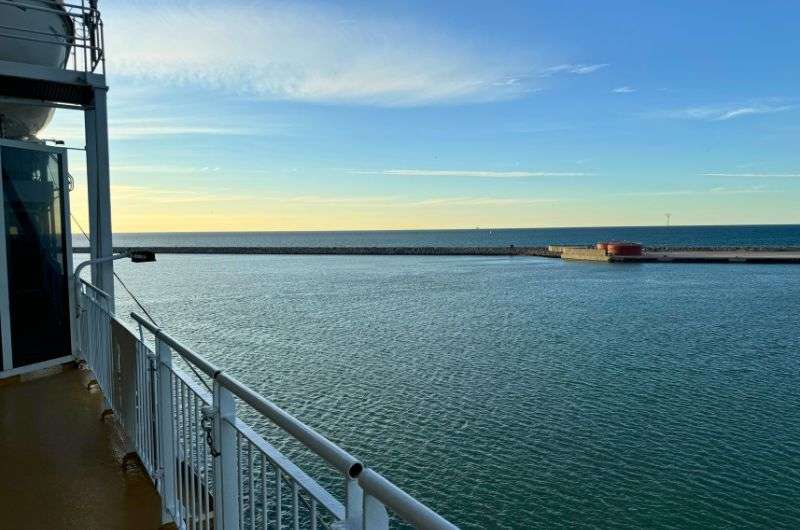
On of the options is to get the ferry to Kristiansand like I did
- Option 1: fly to Oslo. Oslo is the capital of Norway and so from most places, the easiest city to reach via airplane. If you choose to rent a car in Oslo, allow 8 hours for the journey to Stavanger (where this itinerary properly begins). Alternatively, catch an onward domestic flight to Stavanger and pick up a car there.
- Option 2: fly to Stavanger. Stavanger Airport is the country’s third-busiest—you might be surprised by how many flights it gets. If you can find a connection to Stavanger that works for you, I’d say take it, as it’s by far the most convenient way to begin this Norway itinerary.
- Option 3: get the ferry to Kristiansand. This is the best thing to do if you want to come from mainland Europe with your own car. We did this—let me take you through the experience in more detail...
Agenda for day 0:
- Take the ferry from Denmark to Norway (for 3 hours)
Hotel recommendation: Radisson Blu Caledonien Hotel in Kristiansand
Further reading: The Best Time to Visit Norway | Northern Lights | Fjords | Next Level of Travel
Driving to Norway from mainland Europe? Skip the 10-hour road slog by hopping on a ferry! You just need to drive up to Hirtshals in northern Denmark, and at Hirtshals harbor, you’ll encounter what looks like a giant snake in front of the terminal. (Okay, that’s what we encountered, as we got cocky and arrived late.)
Pro tip: Check-in itself only takes about two minutes, but because you’ll be waiting to board the ferry anyway, it's best to show up around an hour before departure. That way, you’ll be somewhere in the middle of the long line, if not at the front.
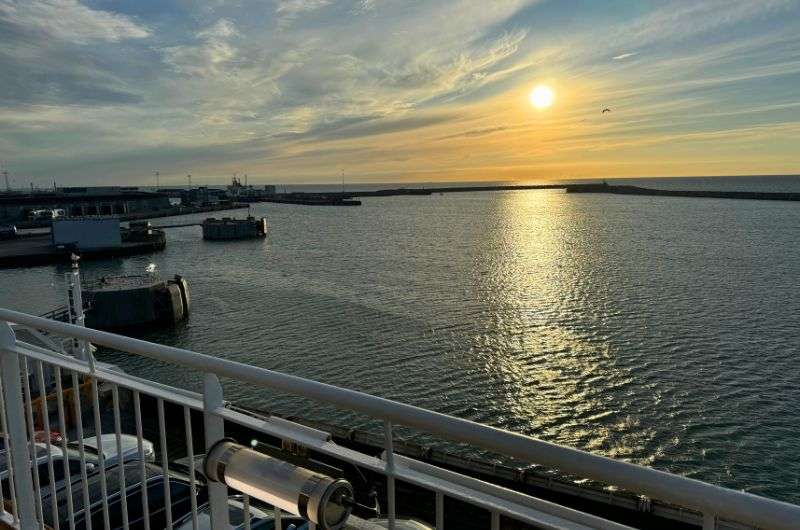
Everybody on board!
Key information about the Hirtshals to Kristiansand ferry
- Ferry operators: FJORD and Color Lines
- Frequency: 39 crossings in high season (June–September) and 18 crossings otherwise, per week
- Duration: between 2.5 and 3.5 hours
- Distance: 117 km (73 mi)
- Price: around EUR 150 (USD 158) one-way, for two adults and a standard vehicle
We opted to take a Color Line ferry, and it was huge. We’re talking hundreds of cars inside a 7-story setup, and it feels like you’re playing a blown-up version of Pac-Man.
Boarding takes a solid half hour, and disembarking is like a slow-motion car parade, taking 20 minutes at least. But hey, when it’s actually moving, this beast of a ferry covers 117 km in just 3 hours. And the ticket’s EUR 150, which beats the cost of driving 1,000 km (621 mi) through Sweden, when you factor in gas, wear and tear, and your will to live.
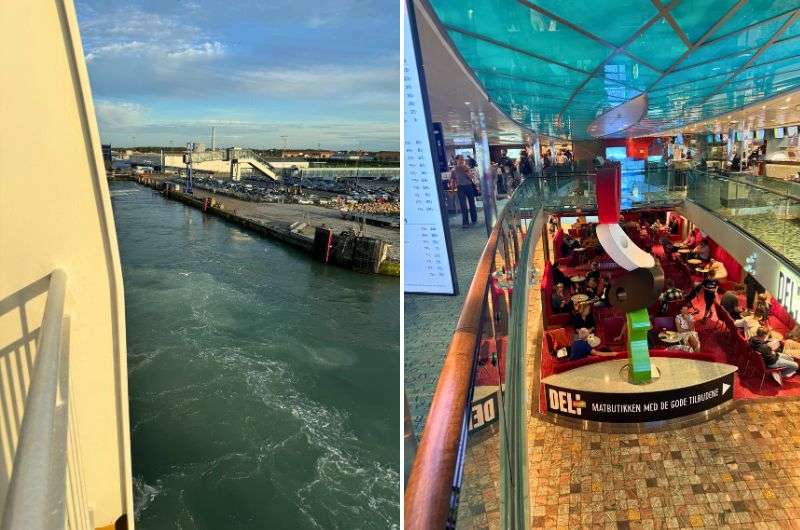
In 2.5 or 3.5 hours you are in Kirstiansand
Amenities on the Hirtshals to Kristiansand ferry
The ferry itself was surprisingly fun to explore as there’s loads of space to roam. Deck 9 was premium class—not for us peasants. Still, coffee is a wallet-friendly EUR 3 (USD 3), the dining options are decent, and the bathrooms are squeaky clean. Looking out to sea, I caught a glimpse of some military ships just casually sharing the Skagerrak Strait with us.
You can also entertain yourself with the arcades and shopping outlets (though they stock more whisky than Lego, which doesn’t feel right). And don’t forget—since Norway isn’t in the EU, you can claim duty refunds on the stuff you buy. Look for the Global Blue office onboard and make sure you have your paperwork with you—car decks are locked during the trip.
One downside: The onboard Wi-Fi is your only shot at avoiding a massive phone bill once you hit international waters, so make sure you connect to it as soon as you board.
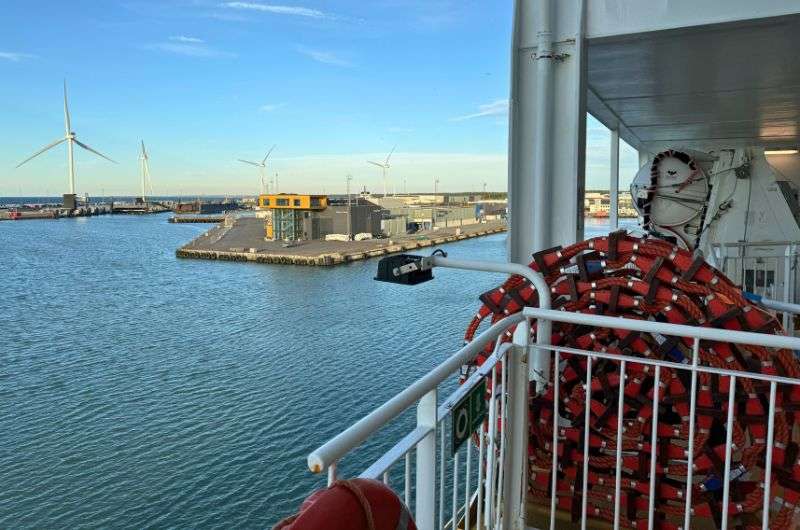
It was fine, but I always prefer to fly
As the ferry pulls into Kristiansand on Norway’s south coast, prepare to inhale the sharp scent of pine trees. It’s magical. But while the journey was cool, it’s a one-and-done experience for us—an ordeal compared to flying.
Next, pull right into the Radisson Blu Caledonian Hotel...
Why I’d recommend staying at the Radisson Blu Caledonien Hotel before beginning your 14-day trip across Norway:
- 24/7 reception: We were zombies when we checked in at 1 am after the ferry.
- Location: It’s right next to the Kristiansand ferry terminal.
- Breakfast: Prepare for an absolute feast, with 150 types of fish on offer. Not a typo.
- Late check-out: Snooze (if you’re that sort of person) and leave as late as 12 pm.
- Big parking lot: You’ll find it behind the hotel, and you’ll pay for parking electronically only once you leave
- Beds: Best mattress ever. I’m ready to write it a love letter.

Day 1: Stavanger and Lysefjord
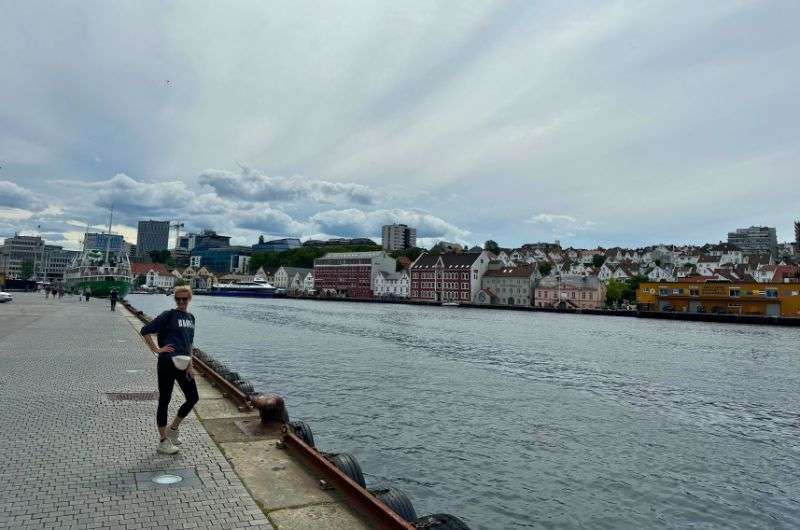
Stavanger
Agenda for day 1:
- Drive from Kristiansand to Stavanger (for 3.5 hours)
- Go on a Lysefjord cruise (for 3.5 hours)
- Explore central Stavanger (for 2 hours)
- Stop at the Sverd i fjell monument (for 15 minutes)
Hotel recommendation: Ydalir Hotel in Stavanger
Further reading: The Best Things to Do in Stavanger
Morning: drive from Kristiansand to Stavanger
Tip: Set off as early as you can as the drive will take at least 3 hours (Google Maps link). We left at around 8 am, making sure to get in early on the Radisson fish breakfast.
This is it: crank up your road-trip playlist for the start of your 14 days in Norway! The road to Stavanger is smooth, surprisingly quiet, and lined with endless pine forests. Wind the windows down and you've got nature’s very own car air-freshener! We passed sleepy towns, the occasional gas station, and a deer or two playing chicken with our headlights.
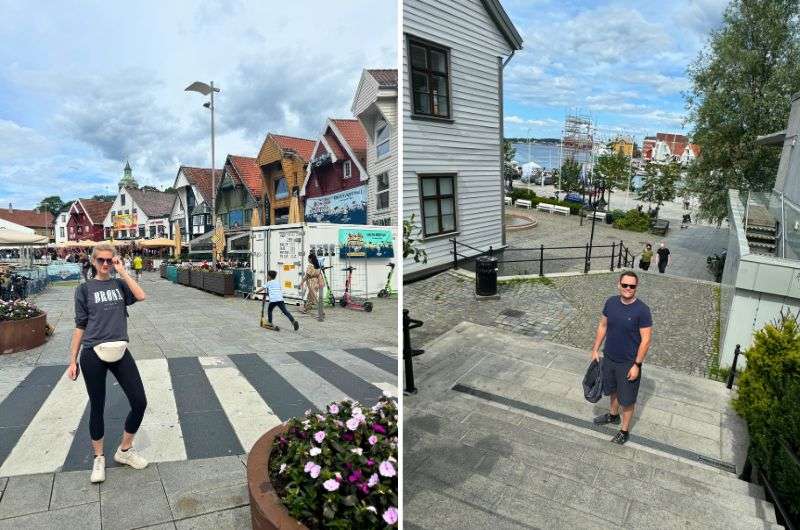
Us, upon arrival in Stavanger
Once we arrived in Stavanger, we went straight to our accommodation of choice to check in. I found Ydalir Hotel modern and comfortable, the rooms are of a decent size, and they offer free parking.
Fun fact: This place is actually a non-profit hotel, with all of its earnings going to the nearby Stavanger University. I thought that was pretty cool!
The only downside? The breakfast. Okay, to be fair, it’s not that the quality of the food was bad; I just thought that that the variety was limited.
Afternoon, stop 1: a Lysefjord cruise
Operated by Rødne Fjord Cruise, this is the thing to do in Stavanger. Lysefjord is one of Norway’s most iconic fjords, so book online directly to avoid overpaying, and do it 2 to 3 days ahead since spots fill up fast. Tickets are around NOK 1,590 (USD 60), and all you need is a QR code to board. The boat departs from the historic harbor, with plenty of parking nearby.
Tip: Check out info on the low-emission zones and parking fees before you roll into the city.
The three-hour cruise starts with an hour-long sail into Lysefjord, with an excellent audio guide dropping fun facts—none of that boring fluff. The boat is quiet, electric, and ridiculously smooth. Pack a jacket, though (and this isn’t the first time I’ll tell you).
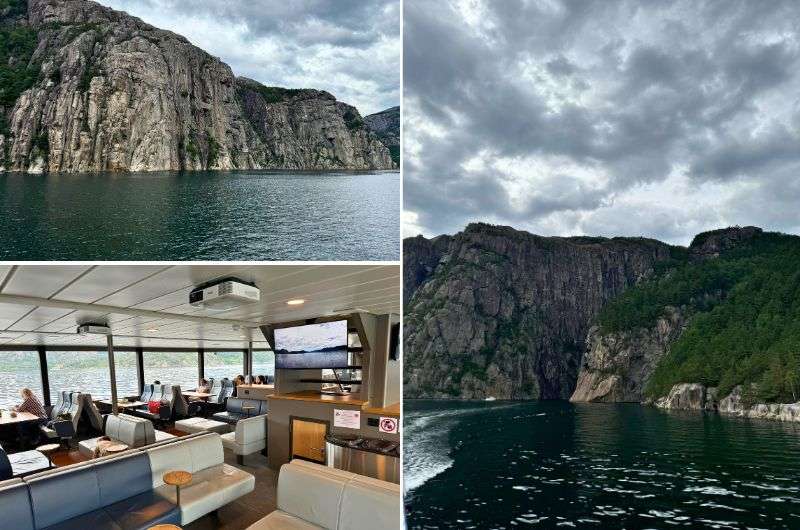
This is sort of what it looked like on the Lysefjord cruise
The scenery is unreal—what a way to kick off your 2-week Norway itinerary. The fjord’s icy waters plunge 460 m (1,509 ft) deep, and the towering cliffs are straight out of Yosemite-meets-Vancouver. Bonus points for the luxury leather seats inside, but you’ll probably want to be on deck for the views.

What is a fjord?...
I’m glad you asked! A fjord is a long, deep, narrow body of water that extends inland from the sea, typically flanked by steep cliffs or slopes on either side. They’re formed by the action of glaciers, which carve out deep valleys as they move. When the glacier retreats, the sea floods the valley, creating the characteristic shape of a fjord.
Afternoon, stop 2: central Stavanger
Back on dry land, and Stavanger is like Norway’s cover model: tall, blonde, and gorgeous. It’s also Norway’s unapologetic oil hub; the locals seem pretty proud of how the crude oil industry has transformed their city.
Founded in 1125, Stavanger is home to about 350,000 people and was once a Viking power center. Today, 22% of its residents are immigrants, drawn by jobs with oil. I also found it wild to see massive cruise ships dock in the old town, unleashing hordes of tourists.
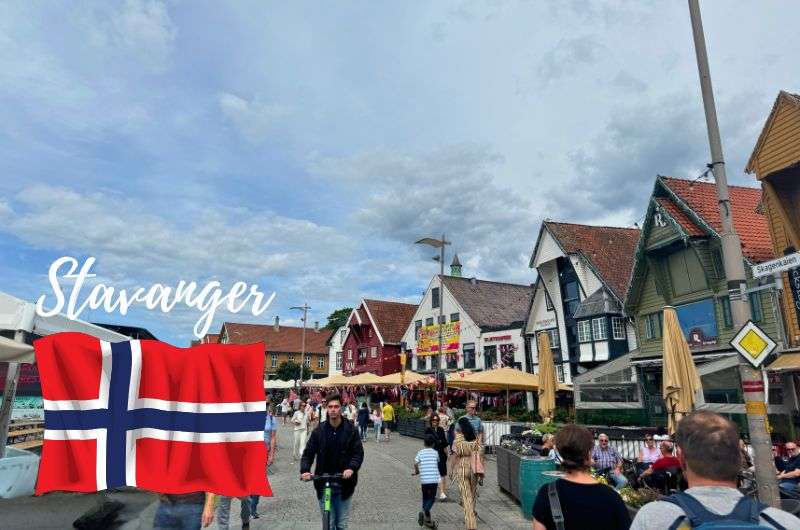
Time to explore the city center
The local harbor and city center are pure Scandinavian postcard material: colorful, picturesque houses and an overall chill vibe. It’s a popular tourist spot, especially on a scorching Norwegian summer day—an almost scandalous 25°C (77°F). Meanwhile, the Old Town is all about cute white houses and Instagram-worthy streets—definitely worth checking out.
Read all about the best things to see, do, and eat in Stavanger in this article!
Afternoon, stop 3: the Sverd i fjell monument
As a history buff, of course, I insisted we stop by this place on the way back to the hotel. Located around 6 km (4 mi) southwest of Stavanger city center, these three massive swords commemorate the Battle of Hafrsfjord in 872, where Harald Fairhair united Norway. The monument is smaller than you’d expect, but it’s undeniably cool.

The Sverd Monument
Fun (and wholesome) fact: The fact that the swords are forever rooted in stone is supposed to symbolize peace.
Day 2: Stavanger and Pulpit Rock hike
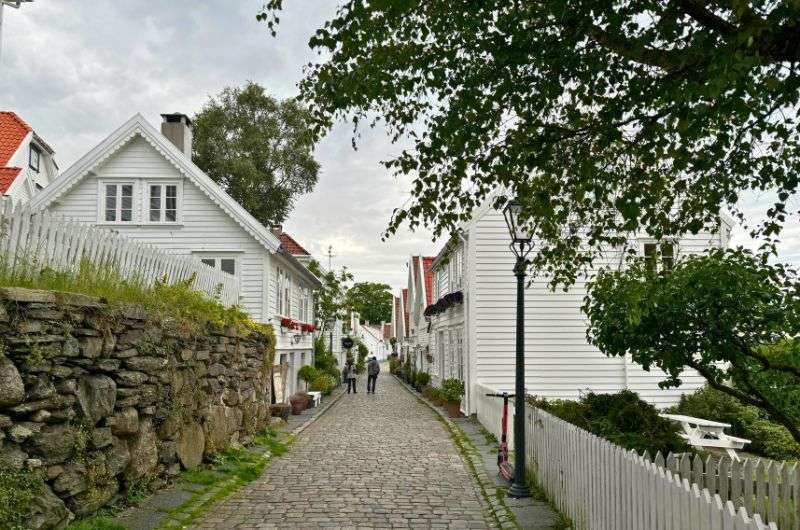
Gamle Stavanger
Agenda for day 2:
- Visit Stavanger Cathedral (for 45 minutes)
- Visit the Norwegian Petroleum Museum (for 2 hours)
- Hike Pulpit Rock (for 6.5 hours, including drive time)
Hotel recommendation: Ydalir Hotel in Stavanger
Further reading: My Experience on the Pulpit Rock (Preikestolen) Hike
Morning, stop 1: Stavanger Cathedral
You’ve got a long day ahead of you, so try to arrive at Stavanger Cathedral as it opens, at 10 am.
Stavanger domkirke is Norway's most preserved cathedral. This Romanesque-Gothic beauty survived fires, storms, and countless renovations, yet its character remains stunningly intact. Because it’s almost completely untouched as of the 14th century, entering it really feels like you’re stepping into a time capsule—a real gem of medieval architecture. I half-expected a medieval knight to stroll by!
Bonus tip: If you’ve got time at this stage, consider wandering down Fargegaten, Stavanger’s colorful street, maybe even to find somewhere for lunch. I’d say it’s one of the coolest parts of the city—it’s like Christiania in Copenhagen, but without the hum of hash in the air.
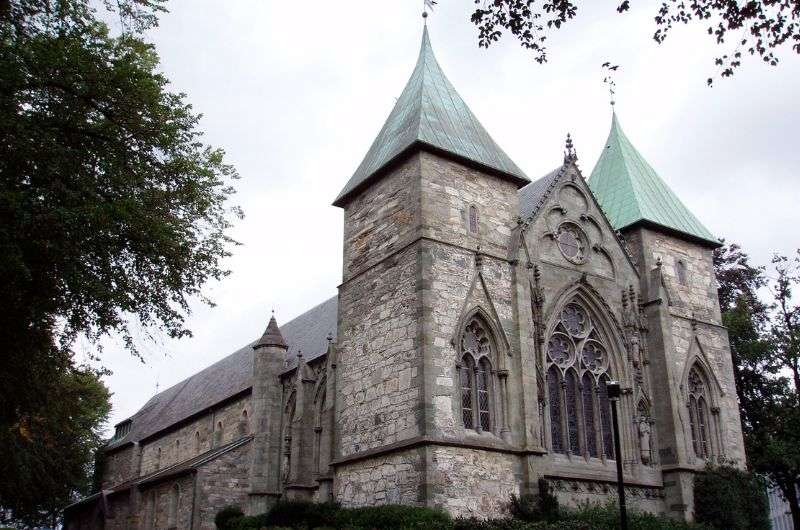
The Stavanger Cathedral
Morning, stop 2: the Norwegian Petroleum Museum
It might not sound that exciting, but seriously, plan to spend two hours here. Tickets are 180 NOK (USD 16), a fair price for a museum this loaded. This place blew my mind—completely original. What did I learn here? Essentially, that the complexity of offshore oil drilling is insane. Think underwater cities built to suck out black gold.
Now, get ready for some crude oil facts: Norway’s pumped about USD 1,000 billion in 50 years, which is USD 300,000 per capita. Oil employs 5-7% of the population, which is nuts, and the profits? Straight into their pension funds. If Norway stopped collecting taxes tomorrow, the country would survive for 20 years. Oh, and they own more stock than anyone on earth.
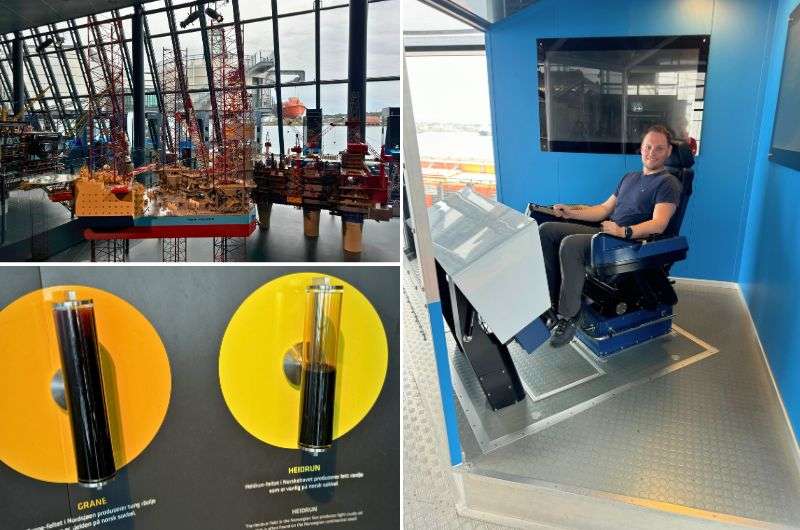
The Norwegian Petroleum Museum
And, as if this museum never needed something else to pull you in, you can try on a rescue suit by Helly Hansen, and even check out a real-size oil platform.
Afternoon: hike Pulpit Rock
Also known as Preikestolen, this cliff is an absolute bucket-list hike, just 45 minutes’ drive from Stavanger. The infrastructure’s top-notch with clear signs along the way and decent parking—just put “Preikestolen hiking starting point” into your GPS.
The hike isn’t so difficult (at least, compared to some of the other treks to come on this itinerary...!); just 4 km (2.5 mi) each way, with an elevation gain of 398 m (1,306 ft). Expect granite paths, forest sections, and epic views along the way.
The trail’s well-maintained, even in the rain, but leave the sneakers at home—boots are your best friend here. Most of the climbing happens in the first 2 km (1.2 mi), so the toughest part is over pretty quickly, while you still have your strength.
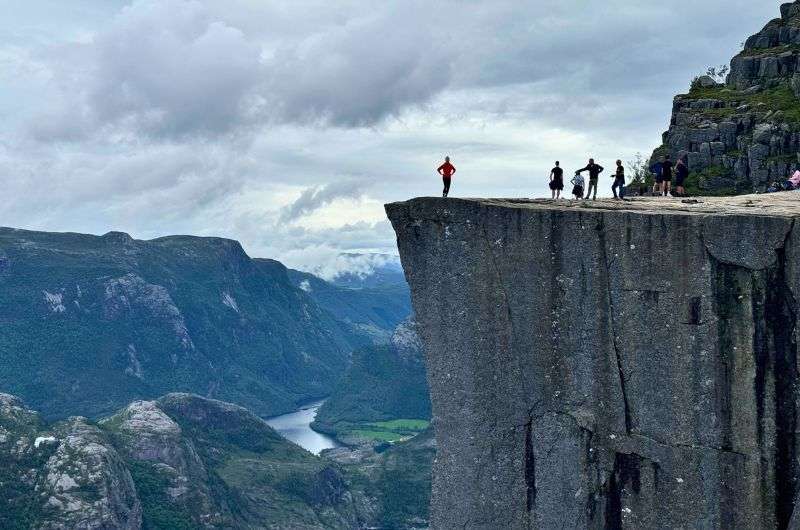
Pulpit Rock
It takes about 1.5 hours to get to the top, but if you’re anything like me, you’ll want to linger along the way. But the summit is pure magic: a natural granite platform jutting out over Lysefjord. The 600-meter (1,969-foot) vertical drop will certainly test your fear of heights (even if you don’t claim to have one). It’s crowded, but the views are worth it—more of those Yosemite vibes.
Pro tips: Go later in the afternoon to avoid the bus crowds, and budget for tolls (NOK 164 [USD 15] one way) and parking (NOK 250 [USD 23]).
To sum up, this is hands down one of the most stunning hikes I’ve ever done—totally worth the hype. You can read about my experience hiking Pulpit Rock in more detail right here.
Day 3: Kjerag/Kjeragbolten hike

Us, conquering the Kjeragbolten
Agenda for day 3:
- Hike Kjerag/Kjeragbolten (for 9 hours, including drive time)
- Drive to Odda (for 5 hours)
Hotel recommendation: Trolltunga Hotel in Odda
Further reading: My Guide to Kjerag and the Kjeragbolten Hike
Morning/afternoon: hike Kjerag
Now that you’ve mastered Pulpit Rock, it’s time for phase two! What’s it like to hike Kjerag, the highest cliff around Lysefjord? Your calves will burn, you'll have awful blisters from your hiking shoes, and you’ll fear for your life at times. But ultimately, this is an experience that I myself will never forget.
The hike starts at Kjerag parking lot, 4.7 km (2.9 mi) from the iconic boulder, Kjeragbolten. (At least, it does according to one of the many conflicting signs.) You kick off at 650 m (2,132 ft) and climb to over 1,000 m (3,280 ft), so pack for chilly weather. Expect it to be 10°C (50°F) cooler than in Stavanger.
Important note: DON’T do this hike in the rain, let alone in the snow. In fact, you’d have a job before you even started, as the road up to the Kjerag trailhead is closed in the colder half of the year.
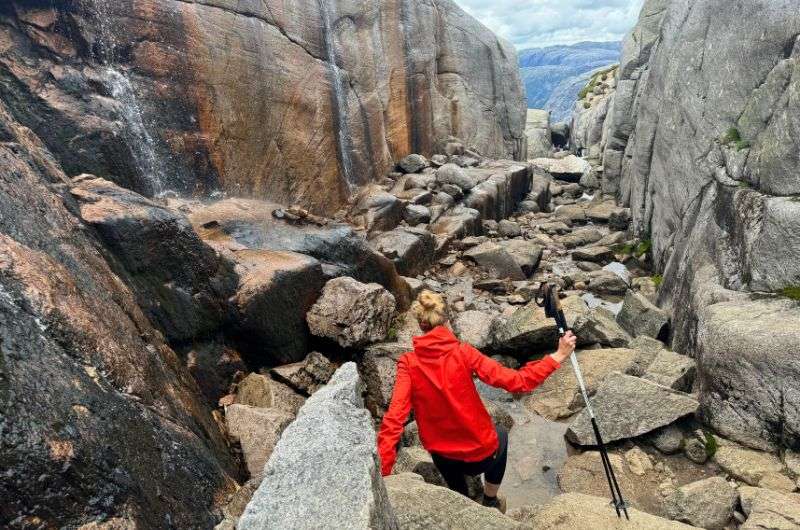
You really don't want to walk this terrain in the rain. That would literally be nuts!
This trail is a granite-lover’s dream (or nightmare, depending on your fitness level). You’re hiking along slanted granite slabs, which are amazing for views but brutal on the legs. The trail is well-marked, foolproof even, but challenging. If steep cliffs freak you out, this one’s a psychological workout, too.
After about 3 hours, you’ll hit the Kjerag summit, which is surprisingly quiet because everyone’s queuing for their “death wish” photo on Kjeragbolten. This giant boulder wedged over a nauseating drop into Lysefjord is the selfie spot for adrenaline junkies (and tourists with a questionable sense of self-preservation). Asians seem to love it; Europeans? Not so much.
Overall, Kjerag is epic, but I’d say the real showstopper is the fjord and gorge, not the boulder itself. The hike’s first stretch is risky, but once you hit the plateau, it’s just incredible.
Get more information about Kjerag, including how to get to the trailhead and answers to FAQs.
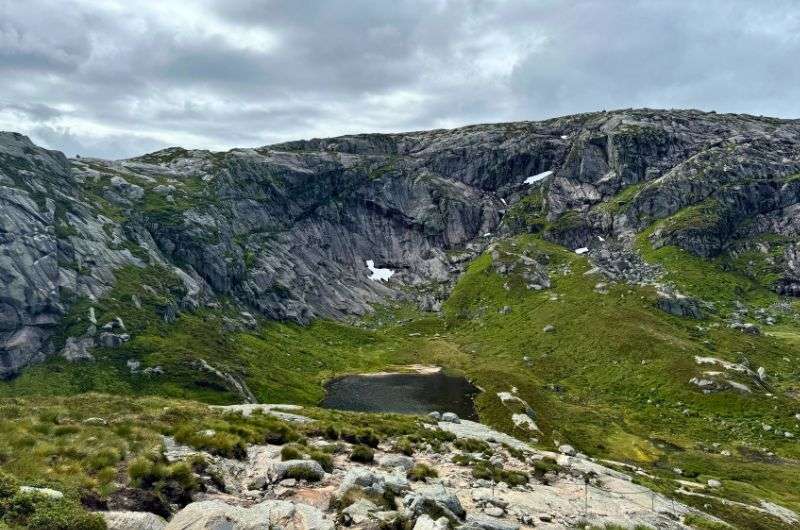
On the Kjerag hike you’ll be surrounded by this beautiful scenery
Evening: drive to Odda
Pro tip: You might feel like you just want to collapse and die after hiking Kjerag. Sure, have a short recharge, but make the drive to your next base on the evening of day 3. The roads will be quiet, and with another hike to do the next morning, believe me—you will thank yourself.
The Hardangerfjord area is the second main destination on this Norway itinerary. As per my tip, do stay in the village of Odda, located at the tip of Hardangerfjord itself. The journey between Lysefjord and Hardangerfjord takes around 5 hours. In this time, you’ll breeze along roads that climb into alpine territory and weave through pretty villages.
It’s almost time to hit the hay (finally!), and I recommend you stay at the Trolltunga Hotel. This is the prime location for the activities to come in the next few days. Plus, the hotel is bright, clean, and cozy.
Day 4: Folgefonna glacier hike
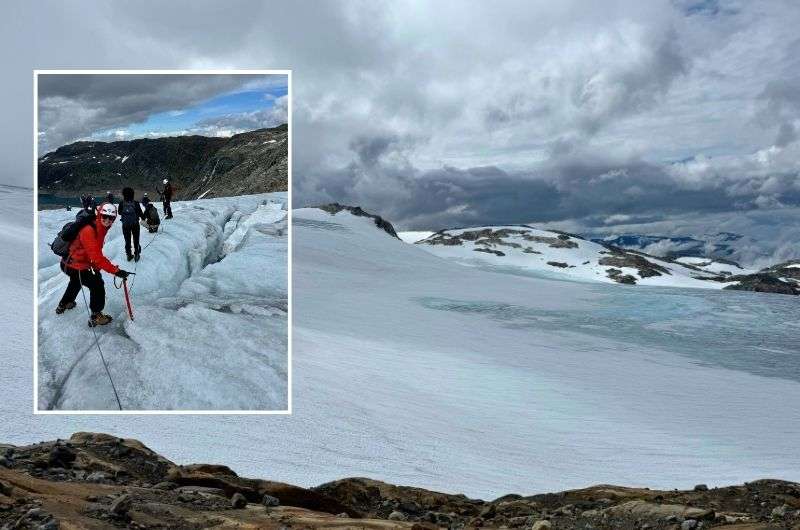
The hike up Folgefonna Glacier is a true Nordic experience
Agenda for day 4:
- Hike Folgefonna glacier (for 6 hours, including drive time)
- Drive to Odda via Jondal and Utne (for 2 hours)
Hotel recommendation: Trolltunga Hotel in Odda
Further reading: Best National Parks in Norway
Morning/afternoon: hike Folgefonna glacier
You can only hike Folgefonna as part of a guided tour in summer. We went with Go Fjords—for NOK 1,905 (USD 174), they take you on an epic 5-hour blue-ice tour, starting at 11 am, which includes rental of ice hiking equipment. But they won’t get you dressed in the morning, so make sure you layer up for when you get there! Seriously—you don’t need to be a weatherman to know that it’ll be cold atop a massive glacier.
Folgefonna is a maritime glacier, fed by massive rainfall from Norway’s west coast (via the city of Bergen, Europe’s unofficial rain capital). Its crevasses aren’t too deep, around 25 m (82 ft) at most, and I can confirm that walking on it is a really cool experience—figuratively and literally.
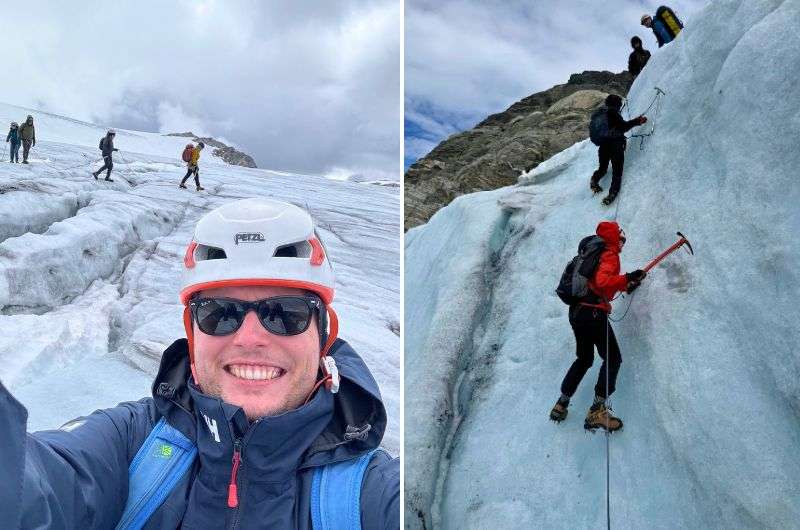
This was so cool!
The guides are pros, so no need to stress if you’re a total newbie. They’ll walk you through every step, crampons and all. We lucked out with the weather—it had been closed for days, and we were the first group to get a green light. Total jackpot!
Here are some other things you need to know before hiking Folgefonna glacier:
- Officially, tour groups are capped at 10 people, but we had 12 in ours, and constantly needing to adjust the rope was a pain. If you can swing it, go for a private guide—it’s faster, more tailored, and way less annoying.
- Learn how to use ice axes beforehand if possible—it’ll save you time and stress.
- The hike is 8 km (5 mi) round trip with a 500 m (1,640 ft) elevation gain. Moderate on paper, but trust me, it can get hardcore fast.

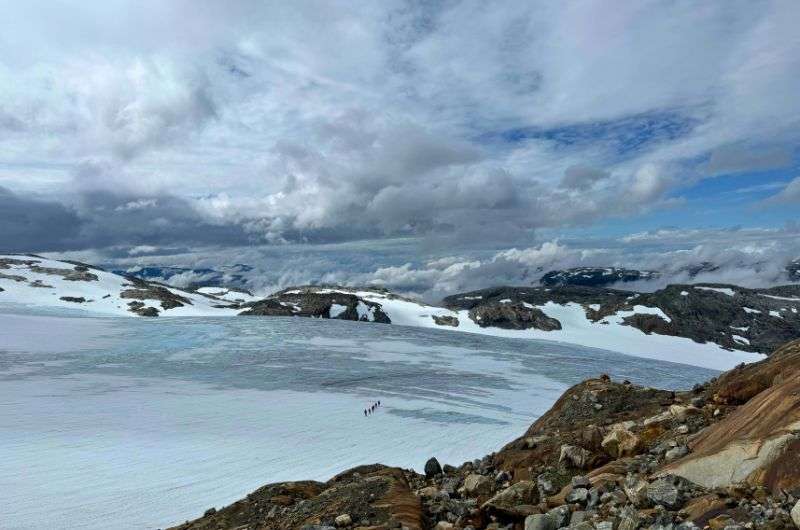
Tourists looking like little penguins
Afternoon: drive to Odda via Jondal and Utne
Now, you could drive to back to the hotel in Odda the sensible way, in approximately 1 hour and 15 minutes. But who ever got the most out of life by being sensible, am I right?
Instead, we took a detour through the other fjordside villages of Jondal and Utne (Google Maps link), and let me tell you: this stretch of road is a feast for the eyes. Winding along such stunning landscapes underneath the late-afternoon sky, unexpectedly, it was just what I needed to wind down from the day. Supposedly, it was 2 hours, but I was so entranced by my surroundings that the time whizzed by.
Day 5: Buarbreen glacier and Nykkjesøyfossen hikes
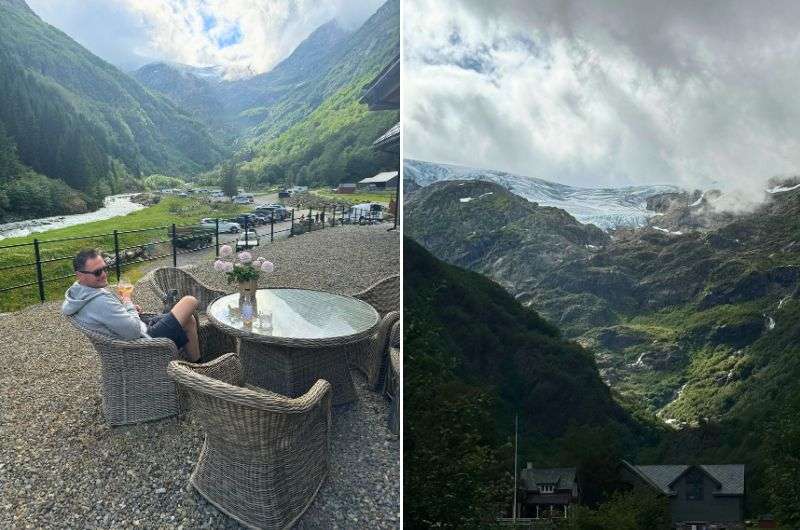
Me, working on my tan, looking at Buarbreen Glacier with a drink in my hand. Now that I’ve conquered it, I feel like I have special rights to this majestic view
Agenda for day 5:
- Hike Buarbreen glacier (for 3.5 hours, including drive time)
- Hike to Nykkjesøyfossen (for 5.5 hours, including drive time)
Hotel recommendation: Trolltunga Hotel in Odda
Further reading: The 10 Best Hikes in Norway
Morning: hike Buarbreen glacier
Buarbreen glacier is essentially one of Folgefonna’s babies, but don’t be fooled—this hike is small but mighty. In other words, it's a natural obstacle course with a challenging incline. If a testing scramble over rocks, ropes, and streams sounds like your thing, then you’ll be starting day 5 of your Norway itinerary right!
First of all, you’ve got to endure the bumpy, one-way forest road from Odda, but the drive is only around 7 km (4.3 mi). The trek kicks off at around 300 m (984 ft), with a waterfall right at the parking lot to set the tone. (And then you’ll realize you have to pay NOK 240 [USD 22] to leave your car there, which dulls the fairytale shine somewhat.)
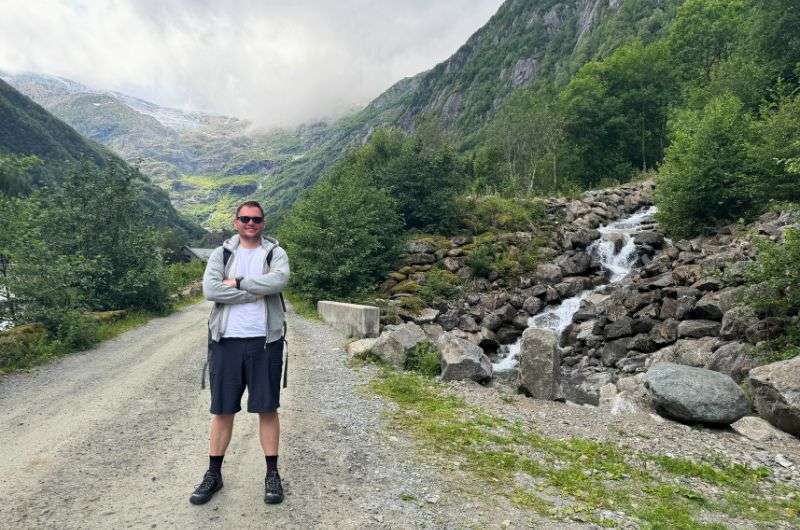
See? I hiked!
This hike is pure drama—a stunning alpine valley with that blue-ice finish. The trail winds through a mix of forest (meh) and open glacier views (amazing). The glacier is absolutely monumental and well worth the effort, but you won’t have an easy time. Make sure you only go as far as you want and turn back if your legs give out.
Tips: Check the weather forecast before you leave the hotel—you’ll struggle to get phone service on this trail. And as ever, dress properly for chilly and unpredictable weather.
Optional: the Norwegian Museum of Hydropower and Industry
For the history nerds and engineering buffs among you, this small museum dives into the local hydropower legacy (tl;dr: waterfalls go whoosh, power goes on—any climate activist’s very literal wet dream).
This is a quirky but interesting potential stop between the day’s hikes, located in the village of Tyssedal between Odda and the next trailhead. Tickets cost NOK 100 (USD 9) and be aware that they’re only open from Tuesday to Friday, and they close at 3 pm on those days.
Afternoon: hike to Nykkjesøyfossen
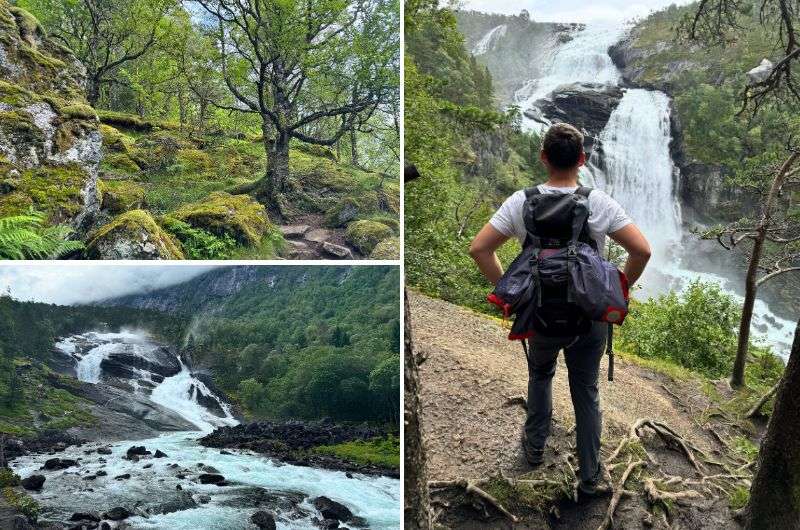
This is what you’ll see on the hike to Nykkjesøyfossen
Located on the northern side of Hardangerfjord, this hike takes you through three (or four) stunning waterfalls, each more impressive than the last. Think of it as a waterfall tasting menu:
- Tveitafossen (200 m [656 ft]): This first monster is just 1 km (0.62 mi) in, wide, roaring, and Instagram-ready.
- Nyastølfossen (400m [1,312 ft]): Even bigger than the first; you’ll feel its spray from 200 m (650 ft) away.
- Nykkjesøyfossen (600 m [1,968 ft]): For most, the majestic climax of the trek.
- Sotefossen (900m [2,953 ft]): Only for the hardcore hikers who are willing tackle tougher terrain (not me, this time).
Good to know: There’s free parking at the trailhead, which is something of a rarity in this country. Bring a good-quality rain jacket because you will get wet at several points. And watch out for blueberries on the trail—they’re delicious but dangerously distracting.
The whole hike is a spectacle, especially in the afternoon sun, with constant views and plenty of spots for photos. Even if you stop at the second or third waterfall, it’s worth it. Just be ready for the terrain to get rough and muddy, especially after the second cascade.
By the way, both of these day 5 hikes made it onto my ranking of the 10 best hikes in Norway!
Day 6: Trolltunga hike
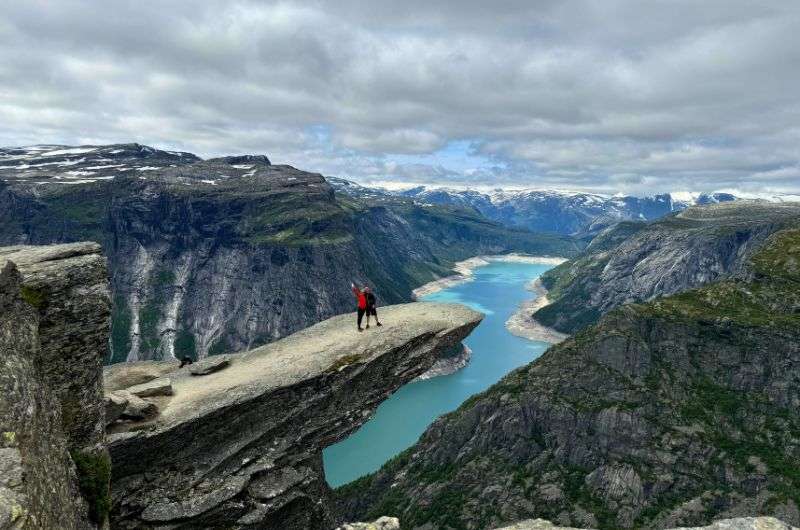
The “Troll’s tongue”
Agenda for day 6:
- Hike Trolltunga (for 9.5 hours, including drive time)
Hotel recommendation: Trolltunga Hotel in Odda
Further reading: My Guide to the Trolltunga Hike
This is one of Norway’s most challenging, but also most iconic hikes. If you’ve never seen any pictures of Trolltunga, it’s a narrow cliff platform perched 700 m (2,297 ft) above Ringedalsvatnet lake. And if you’ve ever wanted to feel like you’re standing on the edge of the world, and like your heart is about to jump out of your mouth, this hike is your ticket.
To drive to the trailhead from Odda is a straightforward, 20-minute job. But because it’s such a popular hike, parking is a bit of a nightmare. Book at least a month ahead for a spot—not kidding.
What you need to know about parking for Trolltunga: There’s a good chance that P3—the parking lot at the actual trailhead—will be full. This means you’ll probably park at P2 (for 500 NOK [USD 45]), which means either an extra 90-minute hike or catching a shuttle bus for NOK 150 (USD 14).
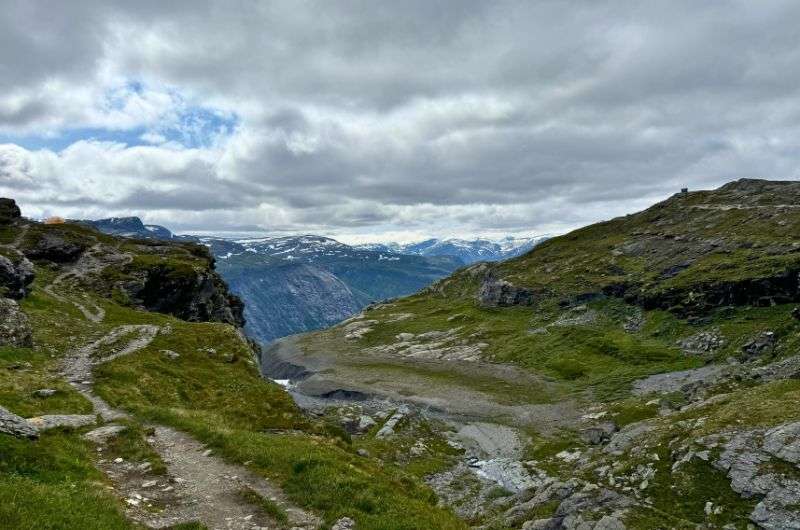
Norway is just amazing
The trail is idiot-proof—clearly marked and easy to follow. The first 2.5 km (1.6 mi) are the toughest, climbing from 330 m (1,082 ft). After that, it’s smooth sailing along a high plateau with stunning mountain-and-lake views (if the weather cooperates). Overall, it’s not a technically difficult hike; just long—it takes around 3.5 hours to the top if you’re moving steadily.
Pro tip: Leave EARLY—this is especially important for Trolltunga. We started at 8:30 am and still waited 30 minutes in line for that iconic photo on the cliff tongue. For even fewer crowds, consider camping for the earliest start, or timing your Norway itinerary so that this day falls on a weekday.
Honestly, although it was hard work, this hike was the perfect way to round off our stay in the Hardangerfjord area, so I can’t recommend highly enough that you do the same.

Day 7: Flåm
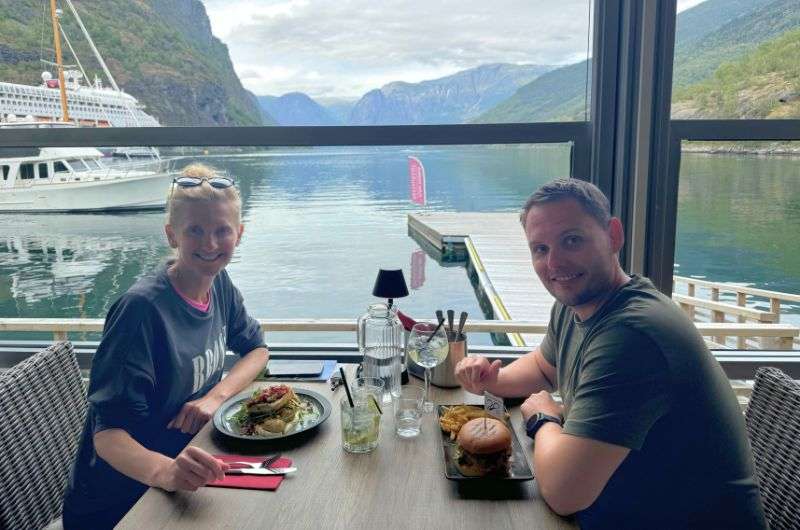
At lunch in Flåm
Agenda for day 7:
- Drive from Odda to Aurland (for 2.5 hours)
- Visit “Viking Valley” in Gudvangen (for 2.5 hours, including drive time)
- Ride the Flåm Railway (for 1.5 hours)
- Hike to Brekkefossen (for 1.5 hours)
Hotel recommendation: Vangsgaarden Gjestgiveri in Aurland
Further reading: 11 Fun Things to Do in Flåm
Morning: drive from Odda to Aurland
Flåm, a small town at the end of Aurlandsfjord, is one of the places people come to when they’re on a “Norway in a nutshell” tour. Yep, the popular, pre-arranged, best-of-Norway itinerary that includes Oslo, Jotunheimen, and maybe Bergen, also includes Flåm and the surrounding area. That should give you an idea of how good it is.
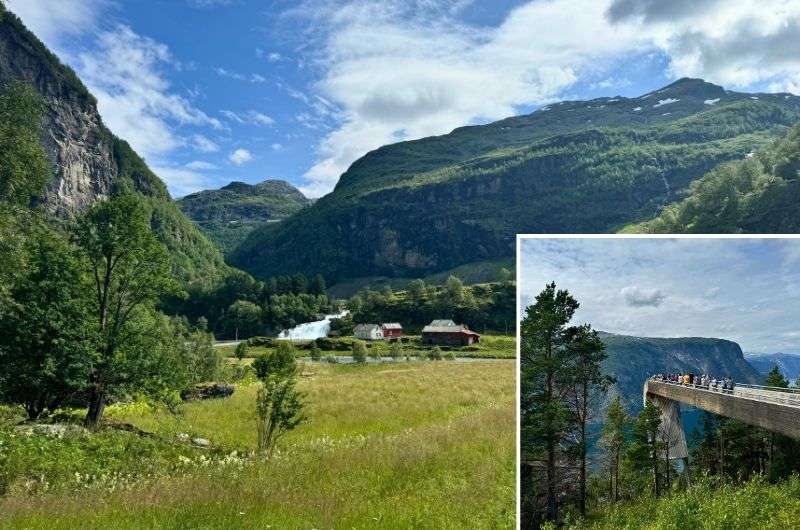
Aurland
Rest assured as you leave Odda that this car journey (Google Maps link) is “only” two and a half hours. (Come on, by Norweigan standards, that’s practically right next door!) Wave goodbye to Hardangerfjord, cruise through some snow-dusted peaks, and say hello to Aurlandsfjord and Nærøyfjord—Norway’s most photogenic cousins, joined in a sort of wishbone formation on the map.
Instead of staying in Flåm itself, we chose some accommodation in Aurland (the next village along, 10 minutes’ drive away). Why? Because in Aurland, it’s less busy, there are no monstruous cruise ships docking in your view, and it’s cheaper.
High praise incoming: Vangsgaarden Gjestgiveri is one of the best places I’ve ever stayed at in Norway. It’s cute and modest—a row of modern, comfy rooms in little individual huts that once belonged to fishermen. And these huts really have got it all: unique charm, a fjord view, and the perfect breakfast.
Morning: “Viking Valley” in Gudvangen
The famed “Viking Valley of Njardarheimr”, tucked into the bottom of UNESCO-listed Nærøyfjord, feels like a genuine Norse retreat. At this open-air museum, the staff stay in character as “Viking villagers”, and guest participation is their game. Okay, it’s a total tourist trap, but they’re nailing the vibe they go for.
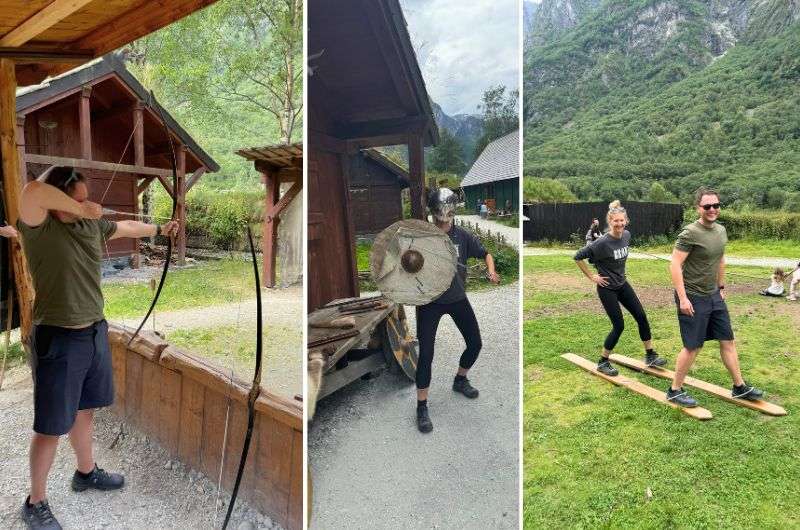
Having fun at the Viking Village
Tickets are a reasonable NOK 235 (USD 21), and the whole place is interactive, with archery, axe throwing, and even “Viking food” to try. We were like kids in a candy shop beneath the grass-roofed huts, learning all about Viking gear, ships, and everyday life.
Afternoon: the Flåm Railway journey
This short, scenic train ride is one of Norway’s top attractions, dubbed “one of the world’s most beautiful train journeys”. It goes from Flåm at sea level to the not-even-big-enough-to-be-a-village of Myrdal, at 860 m (2,822 ft). And back down again, naturally.
The idea is that you get to see one of the most beautiful fjords in Norway, as well as the scenery that surrounds it, while exerting very little physical effort. Think of it like a city tour bus... except without an open top deck, and with the chance of trying sveler (Norwegian pancakes) on board.
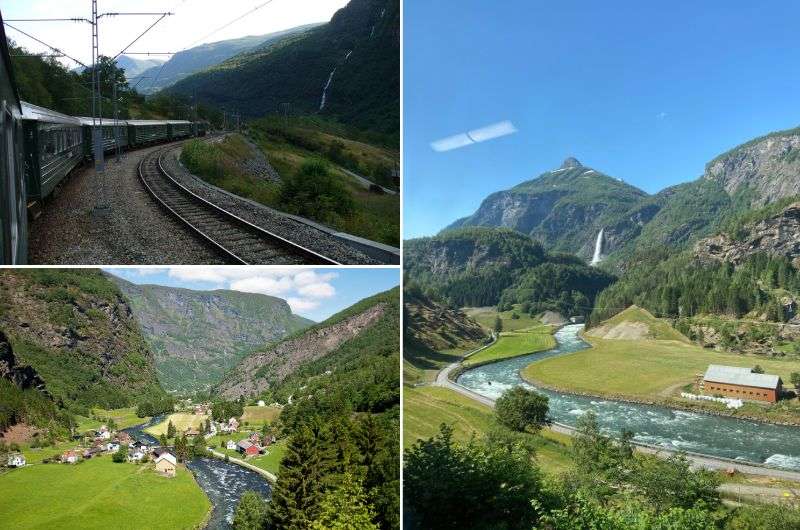
Views from the Flåm Railway
I’ll be honest, the Flåm Railway is a fun, kitsch thing to do and all, but it really is all about the journey. The fjord views you get from Myrdal are nowhere near as great as the ones you get down by the water itself.
Pro tip: There are several tourist companies that offer Flåm Railway tickets, but go directly with the operator, vy.no, for the cheapest deals.
Another pro tip: The hike to Brekkefossen and back is next on your Norway itinerary, but if you’d just like to do the “and back” bit, get off the train returning from Myrdal at Lunden, the station right before Flåm (Google Maps link).
Afternoon: hike to Brekkefossen
The walk to the Brekkefossen waterfall is short but it packs in enough elevation to make you break a sweat. (That is, if you start in Flåm. If you’re starting off the train in Lunden, congratulations—you’ve just hacked your way to a downhill, sweat-free walk!)
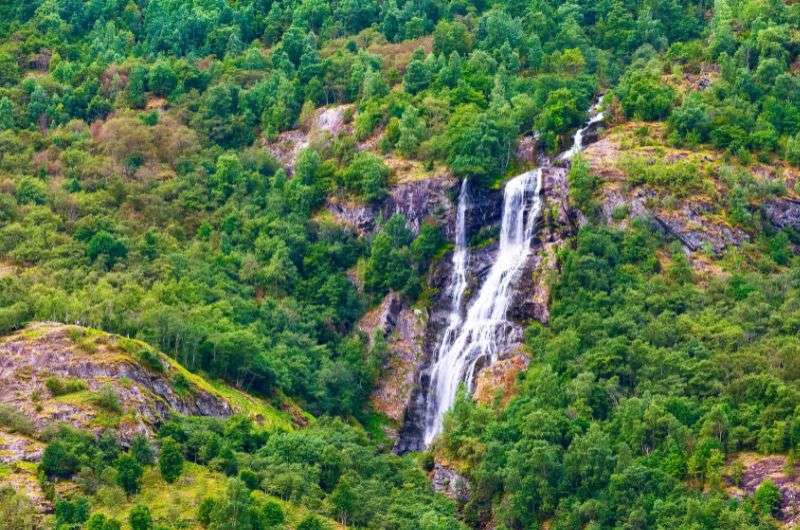
Brekkefossen
The trail immediately goes vertical before winding through lush greenery. The terrain alternates between rocky and muddy, especially if it’s rained recently—which, this being Norway, it probably has. Toward the climax, it opens up to a stunning panorama of the Flåm Valley, Flåm itself, and Aurlandsfjord.
Then, the big reward. Brekkefossen is a thunderous, picture-perfect waterfall that feels refreshingly close to the raw nature of Norway without the need for a multi-day expedition.
Psst—there’s still plenty more to do in and around the area if you can fit it into your Norway itinerary! Check out my extensive list of experience recommendations in Flåm.
Day 8: Aurlandsfjord
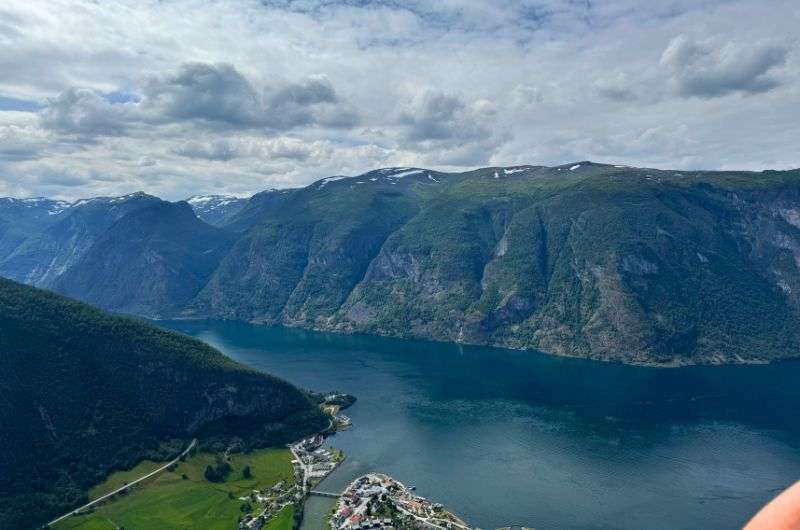
Aurlandsfjord
Agenda for day 8:
- Rent a motorboat on Aurlandsfjord (for 3 hours)
- Try out the FjordSauna (for 1.5 hours)
- Drive to the Stegastein Viewpoint (for 45 minutes)
- Drive from Aurland to Stryn (for 3.5 hours)
Hotel recommendation: Stryn Hotel in Stryn
Further reading: Best Norwegian Fjords
Morning: rent a motorboat on Aurlandsfjord
What’s the absolute best way to experience Aurlandsfjord? Rent a motorboat and go solo. It’s roughly the same cost as a cruise or a so-called “fjord safari”, but you control what you see, where you go, and how long you stay on the water. I’m not the OTT, emotional type, but I swear, this was one of the most unforgettable experiences of my life.
We rented from Flåm Boat Rental, right by the Flåm Marina restaurant. The handover was easy, the boat was simple to operate (you don’t even need a drivers’ license!), and the whole 3-hour experience was well worth the NOK 2,690 (USD 243).
The boat was bumping up and down at 40 km/h (25 mi/h), giving us a good thrill. According to my wristwatch, we managed to explore 62 km (39 mi), reaching Nærøyfjord—the other side of the wishbone. Tip: The inner sections of both fjords are by far the prettiest areas to explore. As they get wider, the cliffs start leveling out.
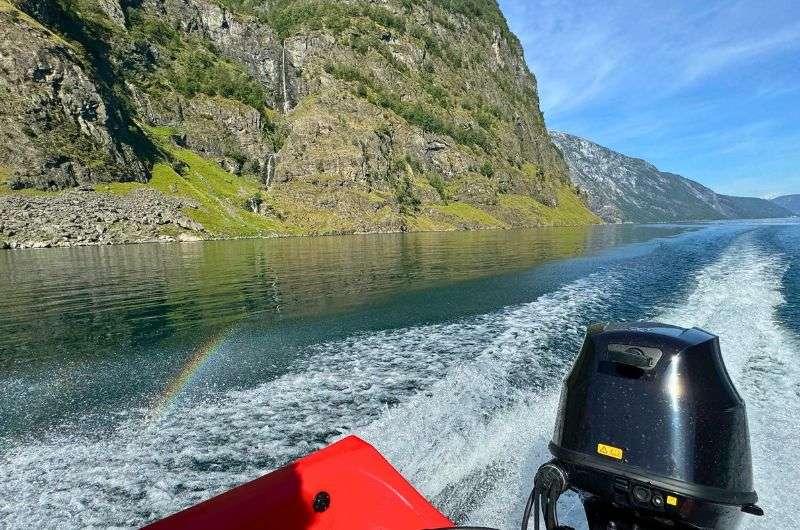
I've said it before and I'll say it again: Don't go on group cruises, rent your own motorboat and do it yourself
The perspective from your own boat is a true game-changer. My personal highlight sights were the waterfalls, a pod of dolphins, and some massive sea otters. We even passed a cruise ship up-close, which was cool but mildly terrifying.
How to boat comfortably: As always, dress warmly! The fjord water is cold (a shocking revelation, I know), and your cruising speed will add some serious wind chill. And ladies, bring a seat cushion. Just ask my girlfriend.
Afternoon: FjordSauna
If you hadn’t gathered, I made day 8 on this Norway itinerary more of a day to chill out (read: no panting your lungs off or scrambling like your life depends on it on any rugged mountain). And quite famously, Norwegians love going to the sauna. So, when in Rome...
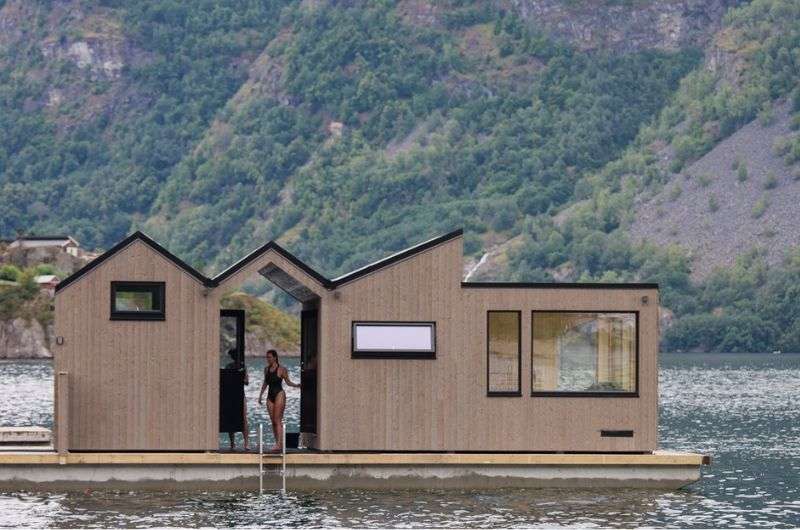
Fjordsauna.com
FjordSauna is a steamy, floating sanctuary where you can sweat away your stress with a stunning fjord view. There are actually two FjordSaunas on Aurlandsfjord—one in Flåm and one in Aurland. And for me, the coolest thing about it was the hatch in the floor in the sauna room itself, so we got to descend into the fjord right there and then.
A few things to bear in mind before heading to the FjordSauna:
- You have to book your session in advance at fjordsauna.com.
- There are no restrooms, so use one of the public bathrooms in the vicinity beforehand.
- Different cultures have different rules when it comes to what (not) to wear in a sauna. To save you from any embarrassment: here, bathing suits are mandatory.
Bonus tip: The Ægir microbrewery is just around the corner from the Flåm sauna, and I could think of no better way to end my sweaty experience than with a cold craft beer. Styled like a Viking feasting hall, it’s a pretty kooky bar, although the service is famously slow.
Afternoon/evening: Stegastein Viewpoint
Built at 650 m (2,133 ft) above sea level, this long platform is only a 15-minute drive from Aurland, and it delivers simply insane views of both Aurlandsfjord and Nærøyfjord. But you need to go late in the day to avoid the crowds! (Or failing that, early in the morning.)
The one-way road up is narrow and nerve-wracking, thanks to drivers who really shouldn’t be on it. But thankfully, that’s the only annoying part. The lookout is seriously stunning, especially in the evening when it’s quieter—you get the fjord’s magical golden hours all to yourself.
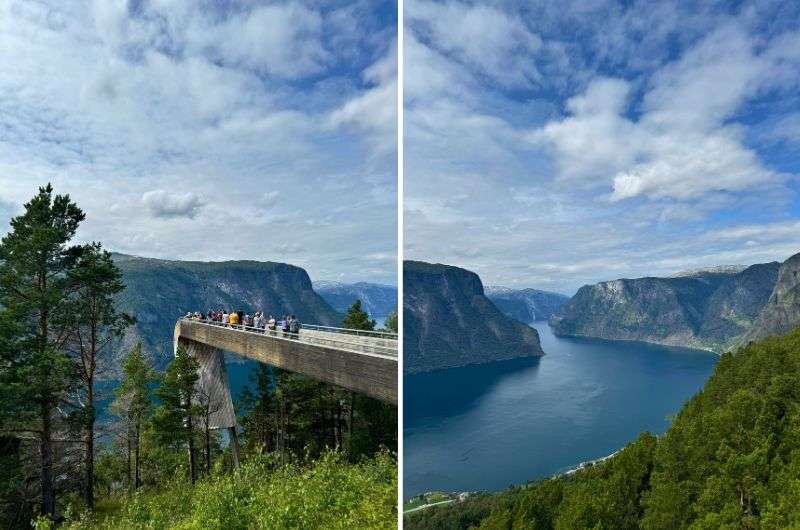
Stegastein Viewpoint
Fun fact: The bathrooms at the Stegastein Viewpoint were ranked among the world’s best public toilets by DesignCurial. Take a look for yourself before the imminent drive ahead...
Evening: drive from Aurland to Stryn
We decided to end day 8 of our Norway itinerary with the onward drive to our next main destination, mainly because it’s quieter on the roads at night.
The journey from Aurland to Stryn—a little valley village near Jostedalsbreen glacier—takes around 3.5 hours (Google Maps link). And by far the most exciting thing about this route is the Lærdal Tunnel, which you’ll enter just as you leave Aurland.
Cutting 24.5 km (15.4 mi) through the peaks, Lærdal Tunnel is the longest road tunnel in the world. The 20-minute drive through this impressive engineering feat is an adventure in and of itself (but brace yourself if you’re claustrophobic). It contains mountain cave rest stops with special lighting to mimic sunrise, as well as its own air treatment plant to combat pollution. Neat, huh?

Lærdal Tunnel—the longest in the world
I recommend you stay in Stryn for easy access to the next day’s points of interest. More specifically, try Stryn Hotel (a name that could have only been chosen for SEO purposes, I imagine). Another gorgeous waterside location, with cozy rooms, a good breakfast selection, and—something that constitutes a minor miracle in Norway—service with a smile!
Day 9: Jostedalsbreen National Park
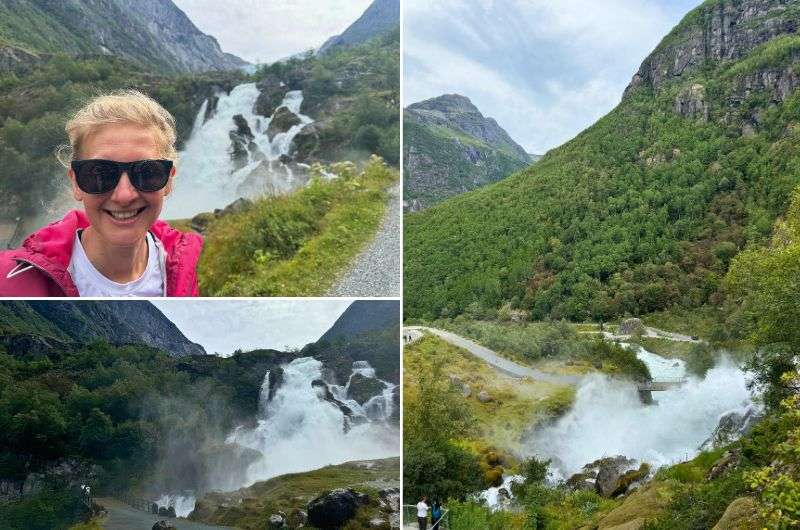
Jostadelsbreen National Park has some nice waterfalls!
Agenda for day 9:
- Hike Briksdal glacier (for 5.5 hours, including drive time)
- Hike to Segestad (for 3 hours, including drive time)
- Hike to Vetledalsetra (for 1.5–2.5 hours, including drive time)
Hotel recommendation: Stryn Hotel in Stryn
Further reading: The Best National Parks in Norway
Morning: hike Briksdal glacier
I struggle to go two days without hiking when I’m on vacation, so here we are again. Jostedalsbreen itself is the largest glacier in continental Europe, but I was told that the Briksdal glacier hike offers everything a keen outdoor explorer could want. And in short, yes, it’s pretty much true.
This is basically Glacier National Park in Montana, but with extra waterfalls, towering cliffs, and Thor-worthy icy vibes. Everywhere you look on this 5.3-kilometer (3.3-mile) trail, what meets the eye is positively unreal. But everyone else wants a slice of the action on this hike, too, so be prepared for traffic, especially if you’re visiting in peak season.
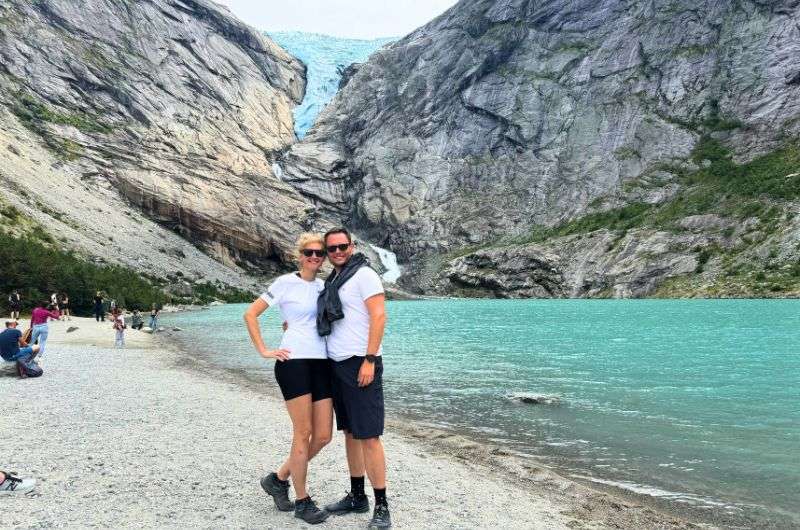
Made it to Briksdal Glacier
Fun glacier fact: These Norwegian glaciers are about 9,000 years old, having been around since the last ice age. It takes between three and 15 years for new glacier ice to “grow”.
The trail starts at Briksdalsbre Mountain Lodge (Google Maps link), a 40-minute drive from Stryn. Parking costs NOK 75 (USD 7), and prepare to come across big buses full of tourists. My advice is to go as early in the morning as you can for the best chance of avoiding the masses.
Afternoon: hike to Segestad
This next hike starts from the village of Hjelle—or more precisely (and weirdly), at , the local school (Google Maps link). If I had no real-world responsibilities, this is the sort of scenic place I’d love to build my own little cabin. Hjelle, I mean; not the school.
First off, the drive into Hjelle from Stryn is pure drama—it’s all granite cliffs and icy crevices. The small parking lots make access tricky, but it’s worth it for the views.
This is a moderate hike with a well-marked path with a steady incline. The trail itself is steep and rocky (and even muddy and slippery if it’s been raining), but it delivers endless photo ops.
Segestad is the climax of the trail. It sounds like a proper settlement, but it’s actually just a little old hut perched on the side of the mountain. I won’t lie—seeing it only made me fantasize even more about my alternative rural life...
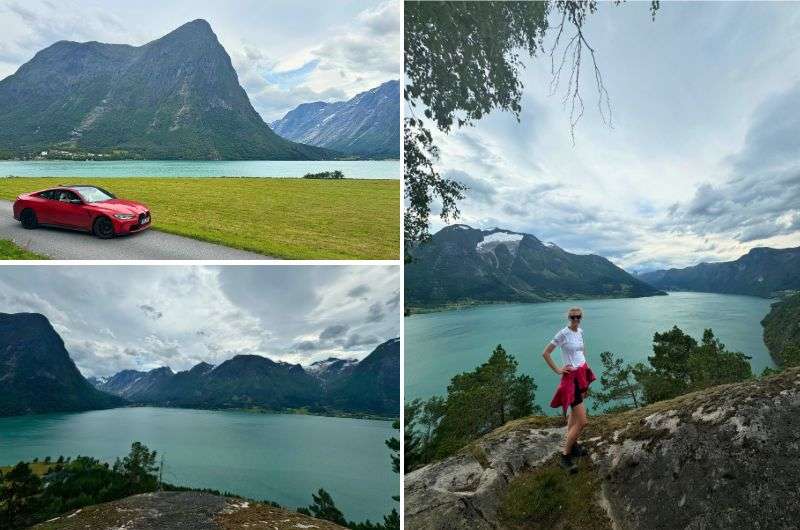
The views in Hjelle

Afternoon/evening: hike to Vetledalsetra
If you’ve still got some energy left, this shorter hike is well worth a quick detour from Hjelle (Google Maps link) on your way back to the hotel.
First things first: make sure you have cash for the honesty box toll at the entrance—don’t be cheap. The whole route to Vetledalsetra (which is actually a farm) is a 10-km (6.2-mi) there-and-back trip and takes around 2 hours.
This glacier-carved valley is stunning, but by all means, stop and turn back along the way if you get tired. Just one tip that might tempt you to keep going: the final views near the 13th trail marker are spectacular!
Day 10: Traveling from Stryn to Ålesund
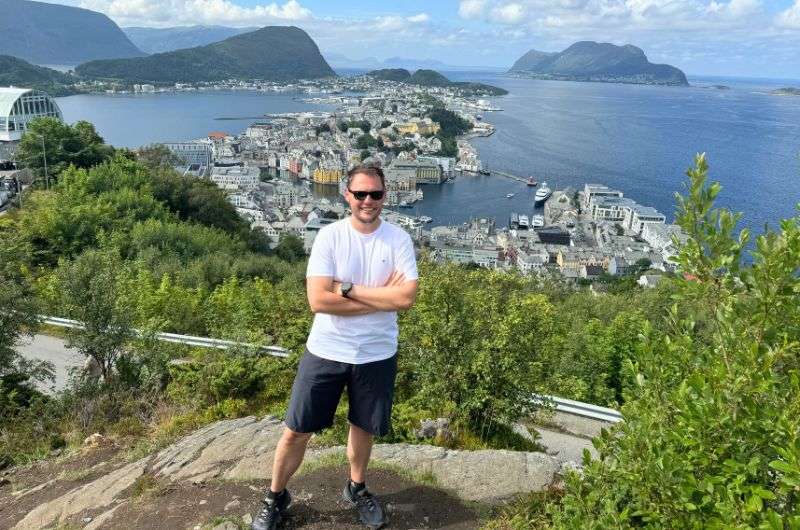
View of Ålesund and a very handsome traveler
Agenda for day 10:
- Drive from Stryn to Geiranger (for 2 hours)
- Drive from Geiranger to Ålesund (for 2.5 hours)
- Visit the Tueneset Coastal Battery (for 2 hours)
Hotel recommendation: Thon Hotel in Ålesund
Further reading: The Best Norwegian Fjords
Morning: drive from Stryn to Geiranger
Give yourself a long sleep before checking out of the hotel—your body will probably need it at this point. Day 10 on our Norway itinerary is when we moved on from Jostedalsbreen National Park to Ålesund, the country’s 13th-biggest, attractive coastal city.
But because it’s us, this wasn’t a straightforward drive. We were eager to brush by Geirangerfjord, the UNESCO-rated golden child of the Norwegian fjords. (Sure, we had it down for day 12, but we were just too curious about even just catching a glimpse. Besides, it was a good place to break up the journey and it wasn’t that much of a detour.)
The drive itself from Stryn to Geiranger is pure cinematic gold. Winding mountain roads snake through lush valleys, past shimmering lakes, and up into rugged alpine landscapes. Even before all that, we stopped at at Øvstefossen as we were leaving Stryn (Google Maps link), a gorgeous thundering waterfall with a viewing terrace so perfectly placed it feels like nature’s VIP balcony.
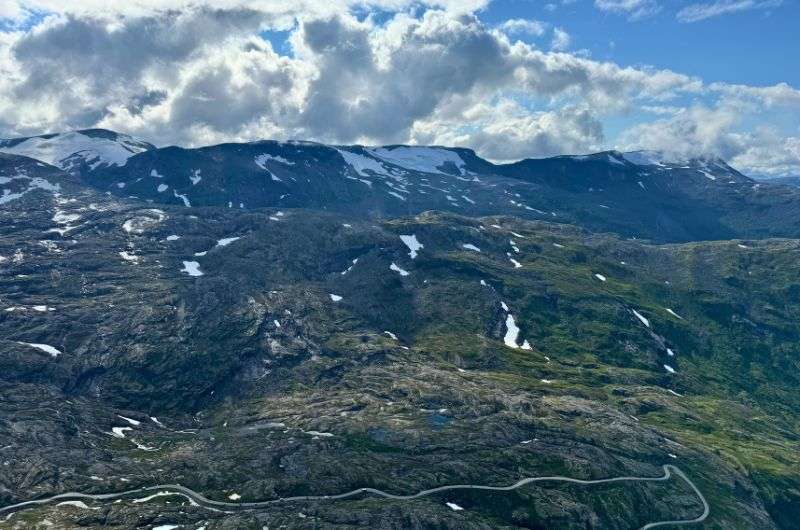
The panorama of Geiranger
Another stop we made as we were approaching Geiranger village was Dalsnibba, the highest viewpoint over Geirangerfjord. Here, the even steeper NOK 330 (USD 33) toll buys you jaw-dropping, signal-free serenity—just you and the epic panorama.
Was Dalsnibba worth the price? I mean, yeah...? It is pretty cool, but maybe only drop the cash if you don’t get the chance to get any other good viewpoints. (More on this when day 12 comes.)
As we descended into Geiranger, the drama certainly peaked and we were lapping it all up: the sheer cliffs, the cascading waterfalls, and the sparkling fjord spread out below. This is Norway at its most iconic—exactly what you see on all the postcards.
Afternoon: drive from Geiranger to Ålesund
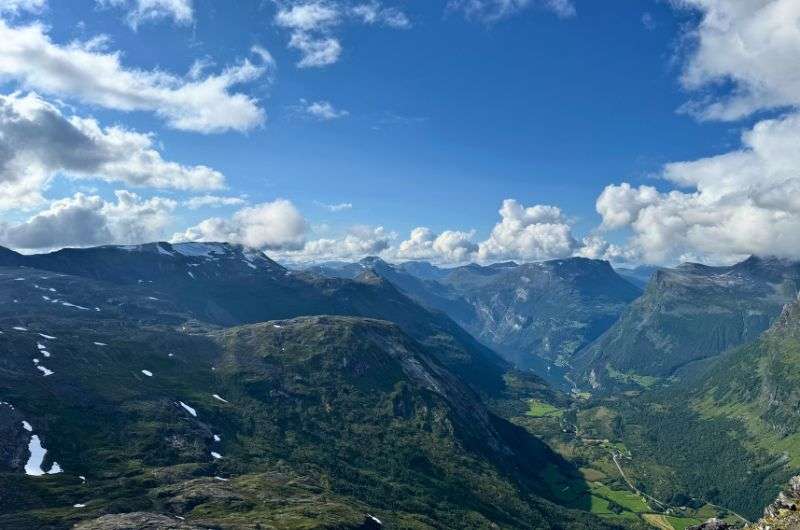
Keep driving!
After looking what felt like forever for a parking spot (by the way, Geiranger is perpetually packed with tourists) and grabbing a bite to eat, it was back on the road. Ålesund is your next base on your two-week Norway trip, and it’s only another couple of hours’ drive from Geirangerfjord (Google Maps link).
My place-to-stay recommendation for this leg is Thon Hotel. Here’s why:
- You’re right in the middle of the city for a reasonable price.
- The rooms are bright and have gorgeous sea views (even if they are on the smaller side).
- They offer a great breakfast with lots of items to choose from, cooked and continental.
Pull into their private parking lot. A space costs NOK 250 (USD 23) per day, but you should be completely desensitized to Norway’s mad parking prices by now.
Afternoon/evening: Tueneset Coastal Battery
Even though all the museums will be closed by now, you should still have an hour or so left in the day to head out and see something cool in Ålesund. But frankly, this is very much one for the boys. In other words, guys, prepare to drag your wife or girlfriend around a bunch of old war machines and make it up to her later.
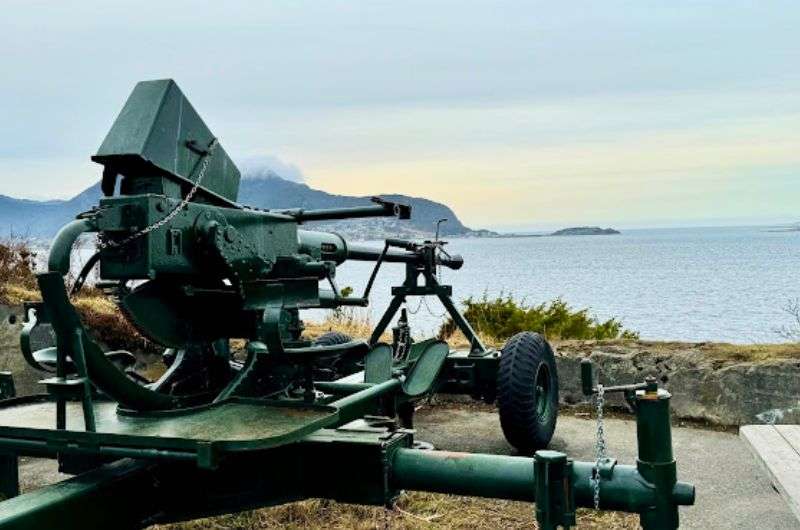
Tueneset Coastal Battery
The Tueneset Coastal Battery on the city coastline is where history meets stellar scenery. Originally a German fortification from World War II, it’s now a peaceful place of abandoned bunkers, rusty relics, and the odd picnic table.
Wander through the old gun emplacements and try to picture the scenes of the turbulent past while listening to the waves crash below. I did, and I lost track of time, totally immersed. (I soon snapped back into the present after my girlfriend sighed what must have been her 57th loud sigh in 40 minutes.)
What I particularly admired about Tueneset is that it’s surprisingly scenic for a former war zone, with walking trails winding around the cliffs and sea views that stretch to the horizon. Bring a camera and a sturdy pair of shoes and head out on a relaxing but poignant evening stroll. You can walk from the hotel and find the treasures in about an hour (Google Maps link).
Day 11: Ålesund

We made it to Ålesund!
Agenda for day 11:
- Visit the Atlantic Sea-Park (for 1.5 hours)
- Visit the Fisheries Museum (for 1 hour)
- Visit Alnes lighthouse (for 1.5 hours, including drive time)
- Hike Storhornet (for 4 hours, including drive time)
- Hike to Byrampen Viewpoint (for 30 minutes)
Hotel recommendation: Thon Hotel in Ålesund
Further reading: Things to Do in Ålesund + My 3-Day Itinerary
Morning, stop 1: Atlantic Sea Park
This aquarium on the island of Hessa is one of the leading tourist attractions in the Ålesund area, and it must be especially fun if you’ve got kids. I haven’t got kids, but I do find sea life fascinating, so we had to go and see what all the fuss was about.
And even though it’s not in the city center, it's just a 50-minute walk from the hotel (Google Maps link). You can drive if you want to, of course; just be prepared for yet another parking fee.
Pro tip: If, in fact, you hate kids, time day 11 of your trip for a school day so you have the best chance of looking around in peace. We didn’t, and oh man, it was loud...
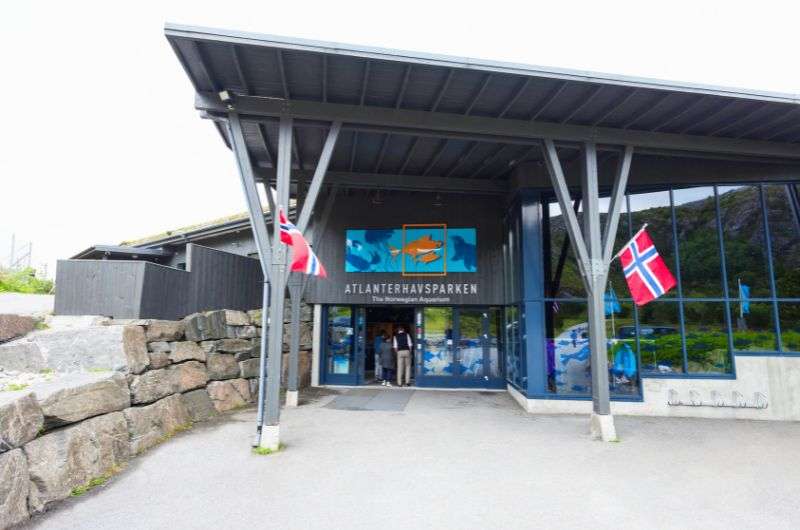
Atlantic Sea Park: I rate it 10/10
As one of Scandinavia’s largest saltwater aquariums, the Atlantic Sea-Park doesn’t disappoint with its array of animals. You name it—you’ll find playful otters, doe-eyed seals, hefty cod (yum), plus some monstrous crabs that look like they could star in their own horror movie!
Overall, this excursion was a fun hour and a half and worth the NOK 250 (USD 23) ticket. Minus all the shrieking children and it would have been even better.
Morning, stop 2: Fisheries Museum
Ålesund’s Fisheries Museum is a dive into the area’s fishing heritage. Housed in a historic warehouse near the harbor (Google Maps link), it’s packed with stories of hardy fishermen who built this city on cod and roe. (And herring. Lots of herring.)
You’ll find vintage boats, fishing gear, and interactive displays that bring this history to life. I tried my hand at knot-tying and read about treacherous sea voyages and hauls that fed half of Europe!
It’s a low-key experience, but the stories are full of charm. Essentially, if you’re curious about Norway’s fish business, they’ll tell you all about it here. It’s a small museum, too, so it should only take an hour of your time.
Afternoon, stop 1: Alnes lighthouse
Alnes lighthouse (or Alnes fyr) is one of the most visited lighthouses in the whole country, so it’s only right to include it in your Norway trip—especially given you’re spending the day in Ålesund. In my opinion, it also might be one of Møre og Romsdal’s best coastal viewpoints.

Alnes lighthouse
It’s situated on the island of Godøya, just 30 minutes’ drive from the center of Ålesund, through four tunnels. (Norwegians can’t get enough of tunnels, which you’ll have noticed by now.)
For a mere NOK 60 (USD 5.50), you can climb up to the top of the lighthouse for the best views of your windswept surroundings. I stared at the sea from up here and thought about the poor fishermen in the 19th century, trying to protect themselves from these frightful waves in just a little wooden boat. For once, I sort of felt grateful to have been born in a landlocked country.
There’s also the “experience center”, an ultra-modern building next to the lighthouse. Jump in here for art exhibitions and a café that offers some pretty tasty cakes. I’d advise you to get some sugar in you before your hike...
Afternoon: hike Storhornet
Godøya is also home to Storhornet, a large hill that makes another great hike, so it makes sense to see the lighthouse and take the walk afterwards.
Storhornet’s got it all: grassy stretches, panoramic views, and you’ll trace the biggest lake on the island, getting views of the smaller islands within it. It reminded me of being back on the Isle of Skye, my favorite island in Scotland. (Check out my two-day Skye itinerary to learn more about how similar these parts of the world are!)
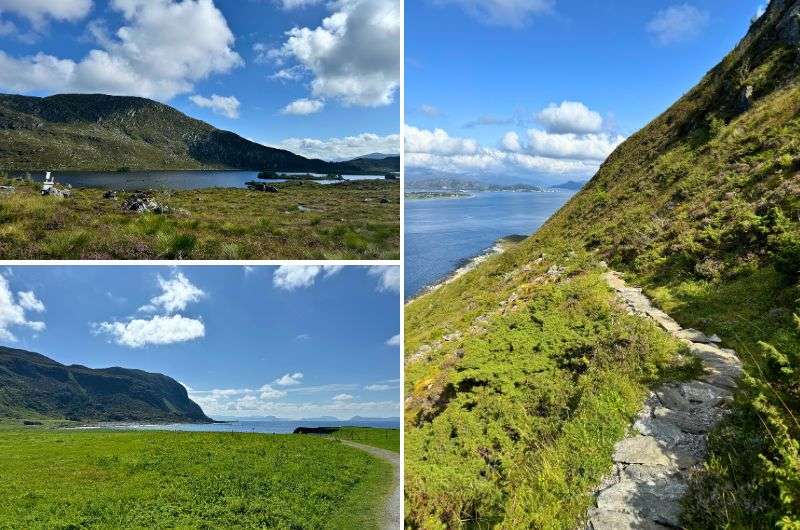
Storhornet is a great hike surrounded by beautiful Norwegian nature
You can choose your trailhead for this one depending on whether you want a quick walk or something more demanding. As we’d just been to the lighthouse, we hiked from Alnes and went right around the lake in a loop.
For more information on Storhornet, as well as all the other places I’ve included for day 11, see my article on the best things to do in Ålesund!
Evening: Byrampen Viewpoint
To top off the day, do this quick climb to get the most amazing views over the city. It only takes 5 minutes and it’s totally worth all the steps!
Pro tip: Most people head up to Aksla Viewpoint, which is very nearby, only it’s not really as great a view and you get charged NOK 100 (USD 9) to go onto the observation deck. Total robbery if you ask me, so save your money and opt for Byrampen instead.
Once you get to the stop, you’ll see straight away in one glance what Ålesund is known for: Art Nouveau architecture, islands, and mountains. I didn’t care too much for the architecture, but picturing everything together, it’s hard to argue against this city being a pretty place. Especially in the summer sunset.
Day 12: Trollstigen and Geirangerfjord
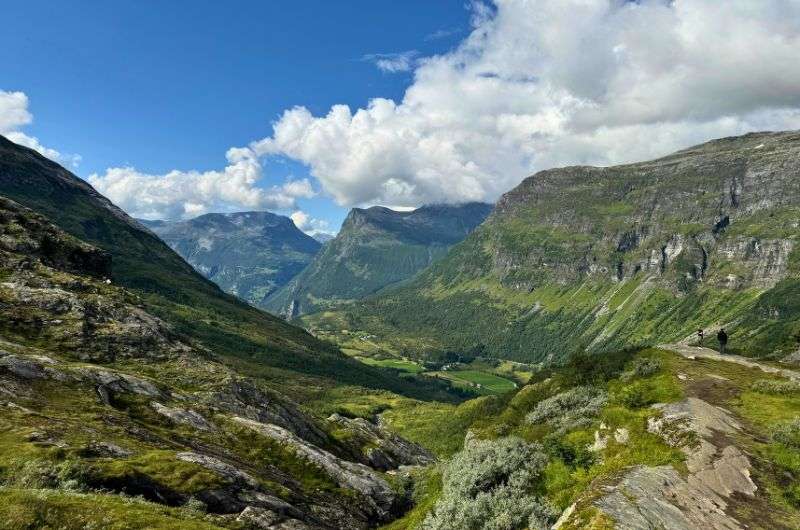
Be prepared for more jaw-dropping views
Agenda for day 12:
- Drive from Ålesund to Trollstigen (for 2 hours)
- Drive from Trollstigen to Geiranger (for 2 hours)
- Hike to Skageflå (for 2.5 hours)
- Go kayaking on Geirangerfjord (for 2 hours)
- Drive from Geiranger to Lom (for 4.5 hours)
Hotel recommendation: Røisheim Hotel in Lom
Further reading: The Best Things to Do in Norway
Morning: drive from Ålesund to Trollstigen
It’s day 12 of your Norway trip, and time to say goodbye to Ålesund. As promised, today you’ll be heading back to Geirangerfjord, but via something pretty damn special.
Trollstigen (“the troll path”) is a steep mountain road that consists of 11(!) sharp hairpin bends. Sadly, as of Decemeber 2024, this crazy feat of infrastructure is closed until further notice due to high instances of large rocks falling from the cliff.
But it’s not all bad news; you can still drive as far as the road’s upper viewing platform (Google Maps link), and the view is incredible. You can even see Trollveggen from up here—the biggest vertical cliff in Europe, which made it onto my list of top natural attractions in Norway.
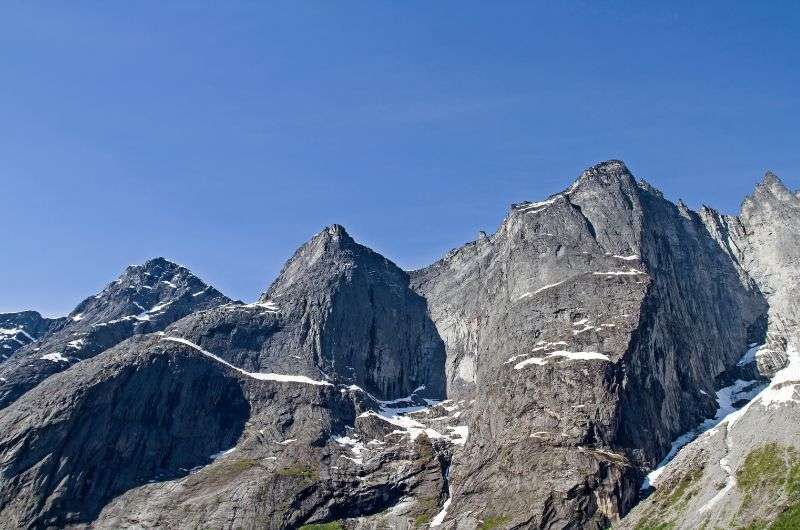
Trollveggen (Troll wall)
Morning: drive to Geiranger
Once you’ve had enough of looking at road bends, prepare to continue on yet another stunningly scenic drive down to Geiranger. As you’ll have noticed, today is a long day, with your activities interspersed with drives (or your drives interspersed with activities, more like).
My advice is to put your foot down at this point so you can have a more relaxed journey in the evening. Don’t worry—there’s still plenty more scenery to come!
Afternoon: hike to Skageflå
Fun fact: Skageflå is an old goat farm which was abandoned in 1916. Frankly, I can't think of many places that are less practical to run a farm than on the side of a cliff. No wonder it was abandoned...
This hike is one of the more adventurous ways to experience Geirangerfjord. Skageflå is one of the better (and cheaper) viewpoints over the water that I was referring to on day 10, in comparison to Dalsnibba.
Take a water taxi from Geiranger to Skagehola (NOK 295 [USD 27] per person). The trail up the cliff is a bit of a beast with its muddy stretches, but in typical Jan fashion, I loved the challenge.
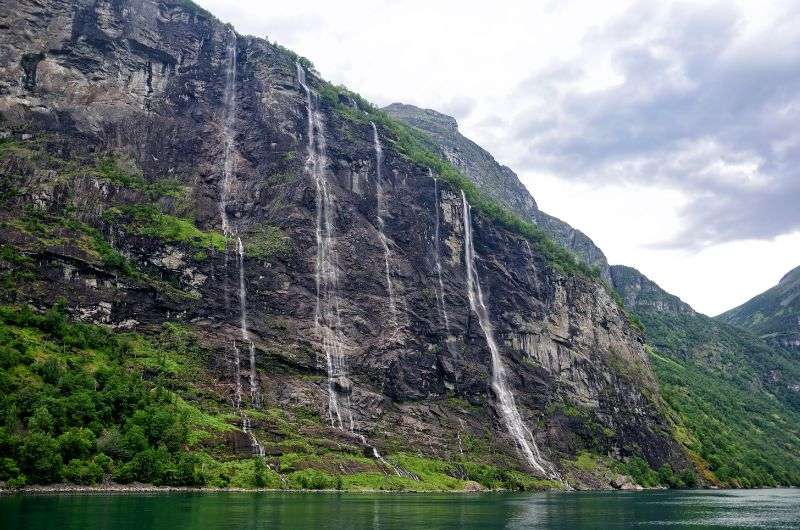
Seven Sisters Waterfall
As we ascended, we soon saw the fjord below and cruise ships that looked like toys gently floating on it. We also caught sight of the Seven Sisters Waterfall, one of the most famous Geirangerfjord sights, in the distance.
Tip: Hiking up to the Seven Sisters will also give you a unique vantage point, so I’d definitely encourage this as an alternative to kayaking. Just be aware that it can get slippery near the water, so wear practical shoes with a good grip.
Afternoon: go kayaking on Geirangerfjord
From up top to down below, we realized we hadn’t yet been kayaking at all on our Norway trip! It was pretty easy to rent kayaks from Active Geiranger for a couple of hours, a fun yet calming way to round off the day. Pro tip: Book online in advance; prices start at NOK 400 (USD 36) for a single kayak.
Much like when we rented the motorboat on Aurlandsfjord, kayaking gave us a cool perspective as we got to paddle right beneath towering cliffs and waterfalls. Again, it's kind of surreal to glide under the shadow of enormous cruise ships passing by. And again (again), be prepared for chilly temperatures—those glacial waters are cold all year round.
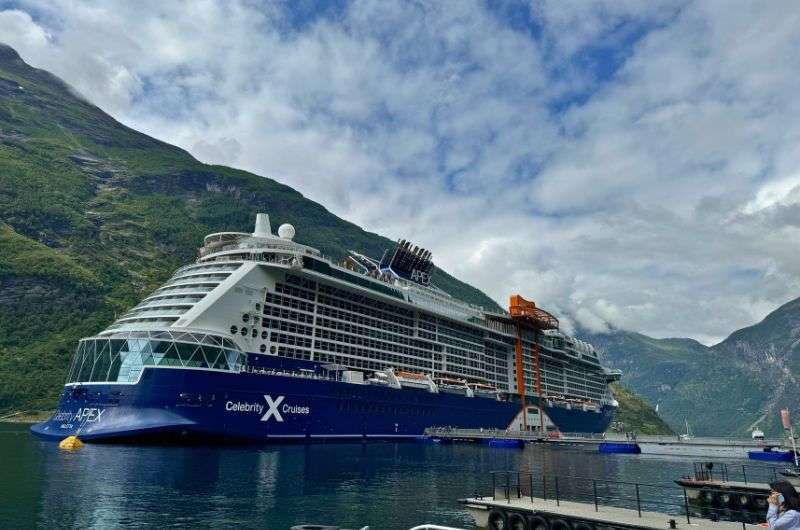
Yes, boating in this big guy can be fun too, but trust me, for the best Geirangerfjord experience, try kayaking
You might also be interested in:

Evening: drive to Lom
You made it—the last leg of day 12! This drive is nearly 5 hours, but this is the best time of day to drive long distances, and your surroundings will soon entrance you enough again to make the time go by more quickly.
On this journey, the winding roads take you past more thundering waterfalls and towering peaks, and through valleys so green they look Photoshopped. Then at some point, it all turns into alpine plateaus with lakes reflecting the sky. Pro tip: Keep your jaw off the dashboard.
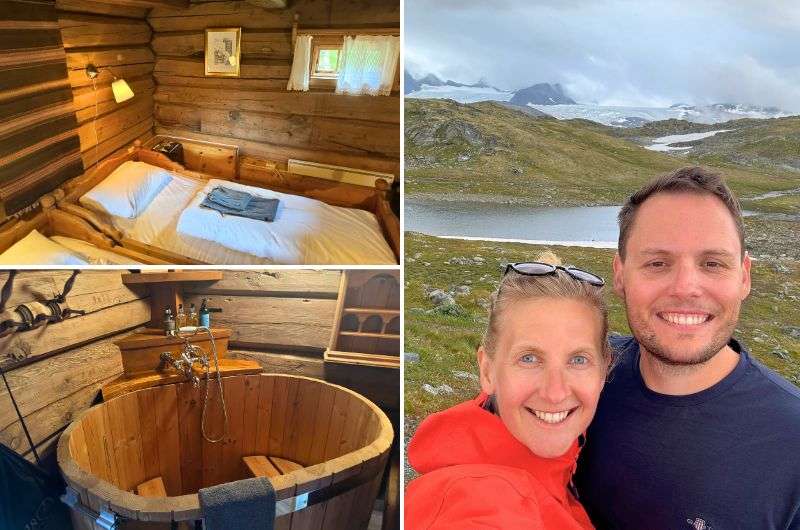
Classic Norwegian accommodation at Røisheim Hotel
This time, we stayed at Røisheim Hotel, which pretty much felt like the middle of nowhere (Google Maps link). The place dates back to 1848, and it’s basically log cabins with a hint of fancy hotel. As you know, I don’t camp or stay in basic lodges (reward yourself with a proper bed, for God’s sakes!), so the “fancy hotel” bit was crucial.
The parking lot is decent-sized—could be bigger—but the hotel itself is an absolute gem, and the kind of thing that makes locals nostalgic. If you want a taste of something classically Norwegian, this is right up your street (or down your valley, as the case may be).
Day 13: Sognefjellet and Vettisfossen
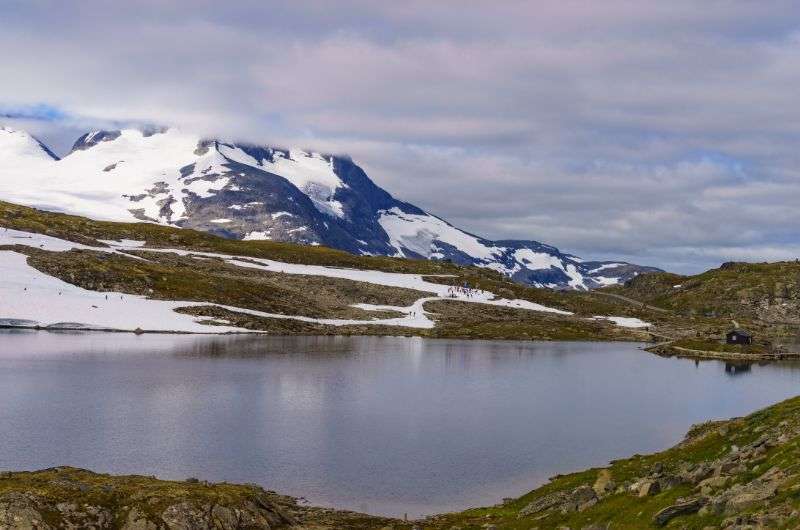
Views on the Sognefjellet road trip
Agenda for day 13:
- Drive from Lom to Vetti Gard via Sognefjellet (for 4 hours)
- Hike to Vettisfossen (for 4.5 hours)
- Drive from Vetti Gard to Lom (for 4 hours)
Hotel recommendation: Røisheim Hotel in Lom
Further reading: The Best Months to Visit Norway
Morning: drive to Vetti Gard via Sognefjellet
Back on the move again—now, prepare yourself for a road trip to remember! Leaving the hotel, you’ll cruise through more dramatic peaks which give way to gentle rivers and charming farmland. It’s a scenic overload, but this is just the warm-up. Sognefjellet is the real star of the show, here...
This legendary “tourist route” takes you to altitudes of around 1,400 m (4,593 ft). Here, the air is crisp, the views are endless, and the landscapes flip between alpine meadows and glacier-draped summits. Although it does feel a bit like you’ve landed on another planet, you are in fact driving on Norway’s highest mountain pass (still a casual flex).
Fun fact: This isn’t just Norway’s highest mountain pass, but the highest in Northern Europe.
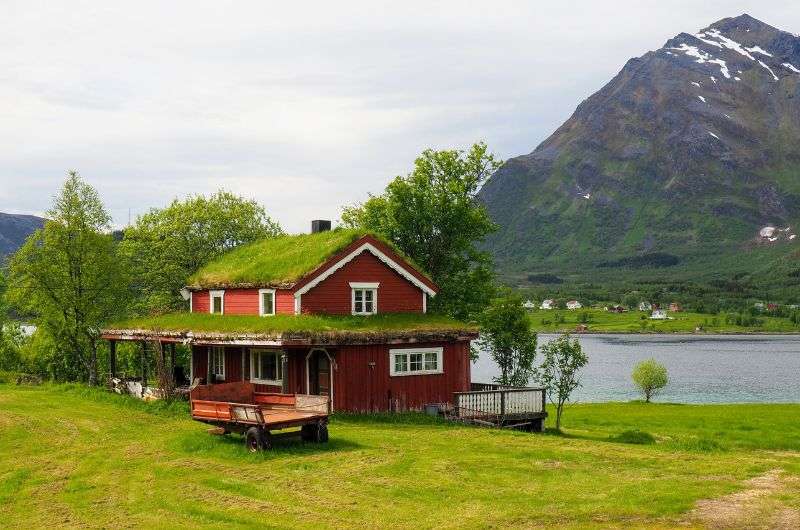
Typical Nordic red houses in Hjelle
We made a pit stop at Nedre Oscarshaug Viewpoint (Google Maps link) for glacier views so surreal they made us feel like the tiniest specks of matter. And we lucked out with clear weather, so the icy giants looked close enough to touch.
From there, it’s more lush valleys as you make your way toward Vetti Gard, the start of day 13’s hike. (All the streams and lakes should give you a clue for what’s in store.)
Overall, the drive isn’t so long, but be sure to bring snacks for it, especially as you’re probably going to linger at Sognefjellet’s every turn, not to mention you’ll need your strength for what’s next...
Afternoon: hike to Vettisfossen
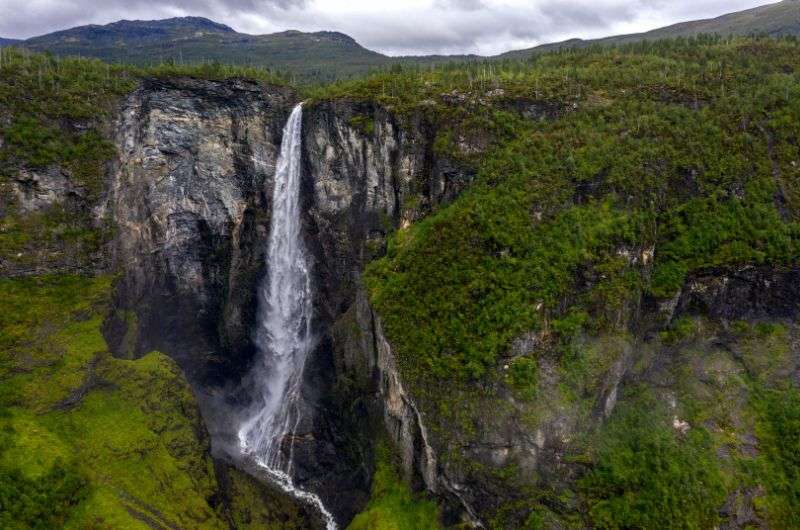
Waterfall on the Vettisfossen hike
You’re essentially spending day 13 skirting around Jotunheimen National Park, one of the most popular national parks to visit in Norway (as featured in my article). This place is all about the tallest mountains and the highest waterfalls, and we decided it was high time—literally—to go waterfall-hunting.
The Vettisfossen trailhead (Google Maps link) is called Vetti Gard and it’s right by a smaller waterfall called Hjellefossen, which is also worth a photo; just try not to get too wet too soon. The hike there and back from this point is around 6.5 km (4 mi) and will take you four to five hours. The road ends quite abruptly just past Hjellefossen, and so you have no chance of driving any closer to save time.
But savor every moment of this, your second-last hike on your 14-day trip to Norway. It starts off relatively easy, on a gravel road along the river. It gets a little muddier, steeper, and more rugged toward the end, but the trail stays well-marked throughout. Sure, it was a bit of a detour for us, but it was very much worth it to get up-close and personal with one final roaring waterfall.
Afterward, you can get back to the hotel the way you came, via beautiful Sognefjellet, or take an alternative, roundabout route that takes over 5 hours (Google Maps link). We drove the former way because we’re not dumb, but I just thought I’d mention it in case, y’know, you are.
Day 14: Besseggen Ridge hike
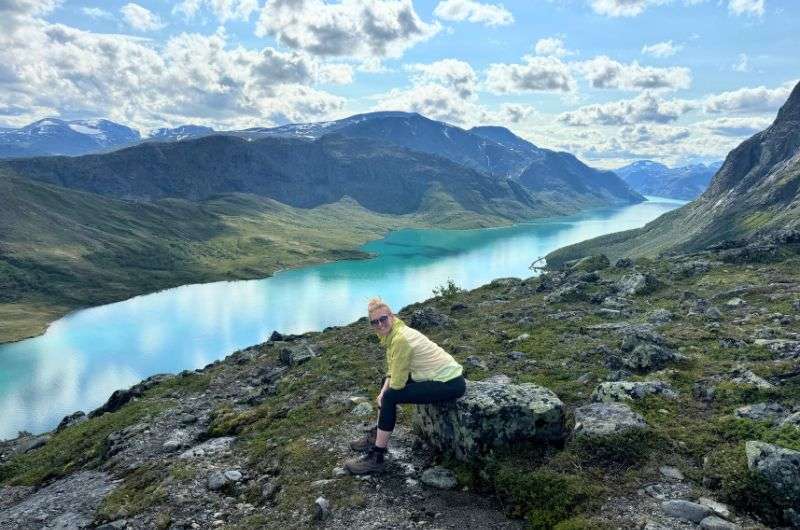
Your last day is all about the epic Besseggen Ridge hike. What a way to say goodbye to Norway!
Agenda for day 14:
- Hike Besseggen Ridge (for 9.5 hours, including drive time)
- Eat at BrimiBue (for 2 hours)
Hotel recommendation: Røisheim Hotel in Lom
Further reading: My Experience on the Besseggen Ridge Hike
Morning/afternoon: hike Besseggen Ridge
The last day on your Norway itinerary is going to consist of driving and hiking—the two things I best enjoyed doing when I was there. (But you know this by now.) And oh man, might I have just saved the best hike ‘til last...?
It only takes around 1.5 hours to drive to Gjendesheim, the Besseggen Ridge trailhead, from Røisheim. You then need to take a shuttle from the large parking lot, 1.5 km (0.9 mi) away from the harbor. Yep, this iconic point-to-point trek pairs perfectly with a ferry ride!
It’s up to you whether you get the ferry first and hike back, or the other way around. My advice? Hike first, like we did. Although coming down the ridge was tough, I was happy to have the steepest uphill climb over with right at the beginning. Plus, there’s something really satisfying about hopping on a boat to cruise past the same mountain you’ve just conquered.

Mind-blowing scenery will keep your legs going
The trail itself is well-maintained, with steps and smooth descents in parts, but it’s no walk in the park. And it’s busy—it’s like a human highway.
Most people choose to do this hike in the opposite direction, but either way, the scenery will blow your mind. The views of Gjende lake and the surrounding peaks are simply insane. And walking along a narrow pass between two bodies of water did make me feel like Jesus—powerful, unstoppable, and proud.
To find out more about this hike, including where exactly the different starting points are, read this detailed article on my experience with Besseggen Ridge.
Honorable mention: Galdhøpiggen is Scandinavia’s highest mountain and isn’t too far from Besseggen Ridge. We didn’t have time to climb it on this Norway itinerary, and in my opinion, Besseggen Ridge is a superior experience. But feel free to substitute it for Galdhøpiggen on your own trip if you’re the sort of person that wants as many bragging rights as they can get.
And after such a mammoth day hike, best believe, you’ll be ravenous. Did you know that Norway is good at fine dining? This is something you have to experience before you leave the country...
Evening: eat at BrimiBue
This place is top gastronomy. And hallelujah, for once in this country, you’ll get good service! It was here that I was convinced that fine dining seems to be the way to go in Norway. Sure, you pay for it, but it’s fairly pricey to eat out anyway, and what you get in return for a negligible difference is off. The. Scale.
We went for the three-course meal with wine, and wow—it was absolute perfection. Each dish was next-level, and the wine pairings hit it out of the park. The owner and our host was a legend, explaining each course and making the experience feel extra special. Most of the ingredients are locally sourced—some even from a farm just down the road, so we were told.
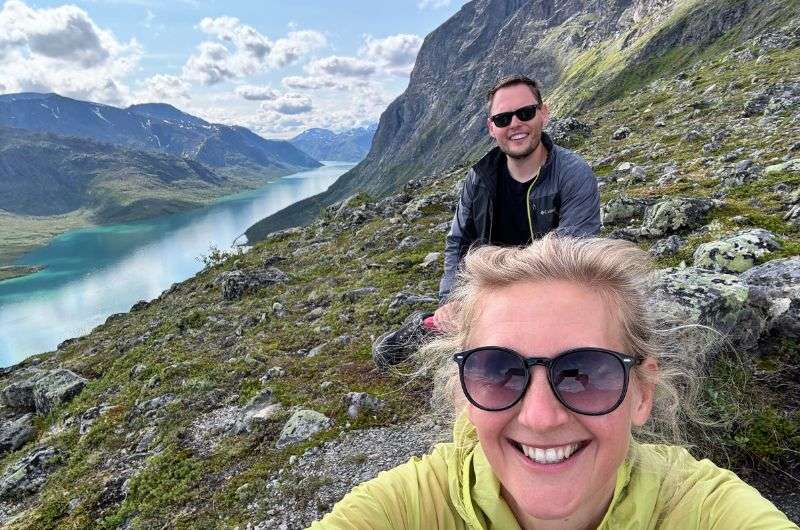
We are proud of ourselves, and we had a reward meal at BrimiBue
The setting is also unreal. Huge glass windows frame views of Jotunheimen, while the open kitchen lets you watch the super-talented team nail every plate. If I had to pick my favorite dish, it might have been the cod in langoustine sauce with tomatoes and mangetout. (This probably won’t be on the menu when you’re there, but it’s just to give you an idea of the magic they put in front of you.)
I’m not suggesting you indulge in food this sublime every night on your Norway trip. (As high as my hopes are for this blog, I don’t suspect it’s a hit with the world’s millionaires just yet.) But your last dinner is the perfect opportunity to lap up a little luxury. And honestly, whether you’re a foodie or just someone who loves an unforgettable meal, I can assure you that BrimiBue in Lom won’t disappoint.
Important note: Nine times out of 10, this place won’t have unreserved tables on the spot. Send a query for a booking at brimibuehotel.no.
How many days are enough for Norway?
14 days is an ideal length of time to spend in Norway if you want to explore the countryside thoroughly (i.e. see more than just the fjords). Don’t forget that Norway is a pretty big country. Drives are long (I drove a total of around 3,700 km [2,299 mi] on this itinerary), and you’ll also want to have time to rest in between your excursions. This is why two weeks is ample time to tackle all the best hikes, visit the charming villages, and get around all the best things to see.
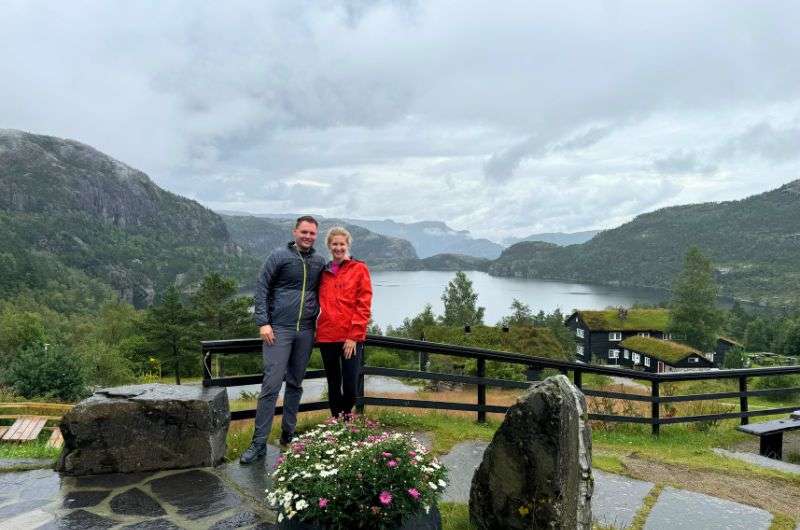
For Norway safe 14 days to see everything cool!
What are the best months to visit Norway?
In my opinion, June to August is definitely the best time to visit Norway, with July being the warmest month. Long days, midnight sun, and ideal hiking weather make summer the peak season. Just be prepared for crowds and higher prices. Many activities on this itinerary depend on a summer visit (e.g. the Sognefjellet mountain pass is closed during the winter).
For a comprehensive breakdown of what Norway is like in each month of the year, including when you can see the northern lights in Northern Norway, see my article on the best time to visit Norway.
Can you visit Norway without a car?
Yes, you can visit Norway without a car, but only if you’re happy seeing a handful of tourist attractions (such as Lysefjord and Folgefonna glacier), if you want to stay in one region, and/or if your Norway itinerary is a nutshell tour. Norway’s trains, buses, and ferries are top-notch, but it’s more difficult to reach more off-the-beaten-path places if you don’t have a car.
Sometimes, all you need to do is take the first step... I've filtered out the best hotels in Norway for you
Save it for yourself to come back to later, or share with your friends on social media!
You might also be interested in reading:
- The Best 1-Week Norway Road Trip
- 11 Must-See Places in Norway
- 7 Epic Norwegian Fjords + Activities
- Hiking Pulpit Rock: My Experience
- The Best Time to Visit Norway
This post contains affiliate links. I earn a small commission if you make bookings through my links, at no additional cost to you. Thank you for your support!




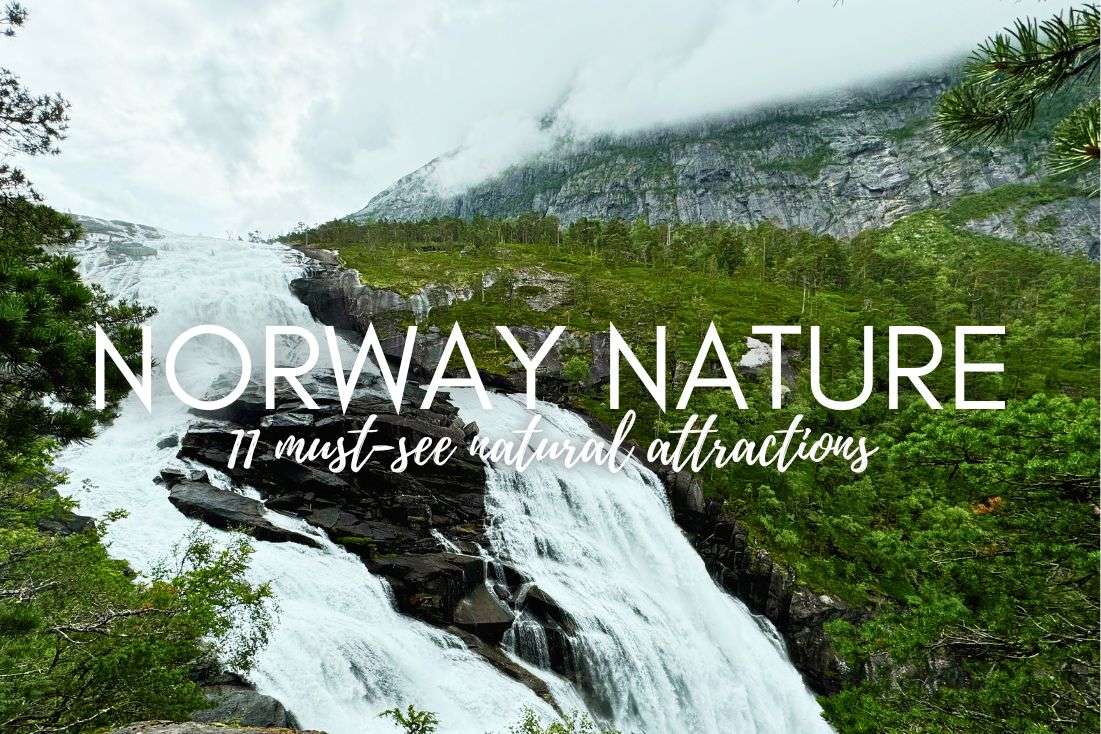
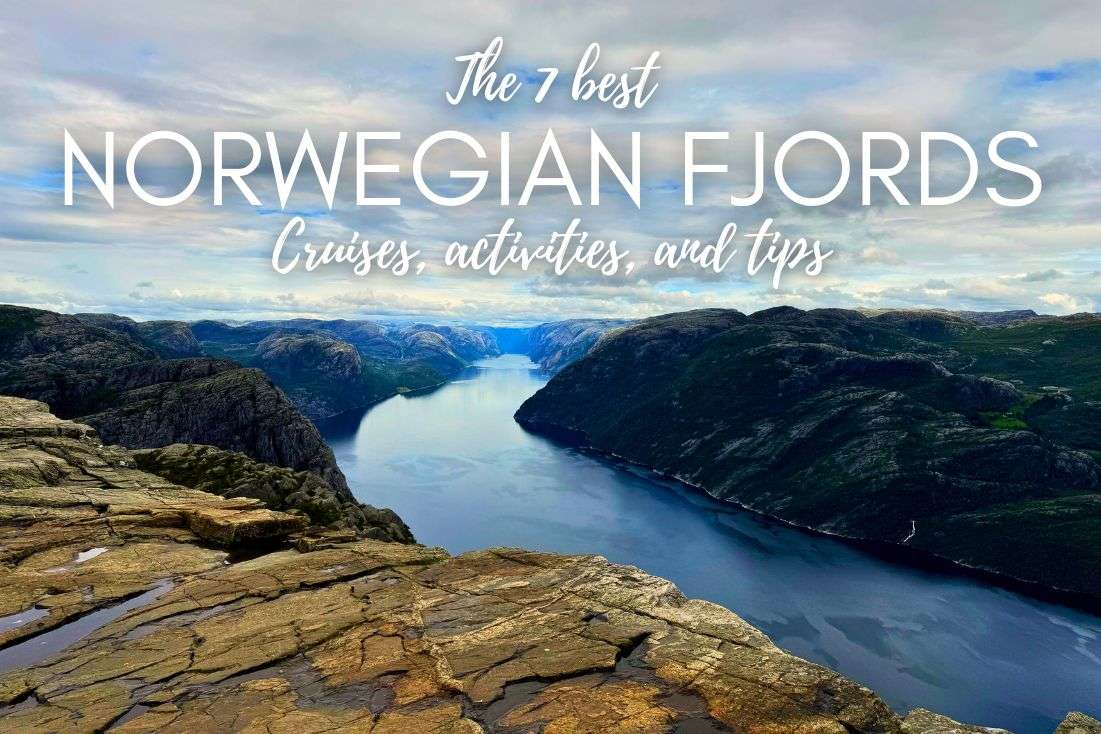
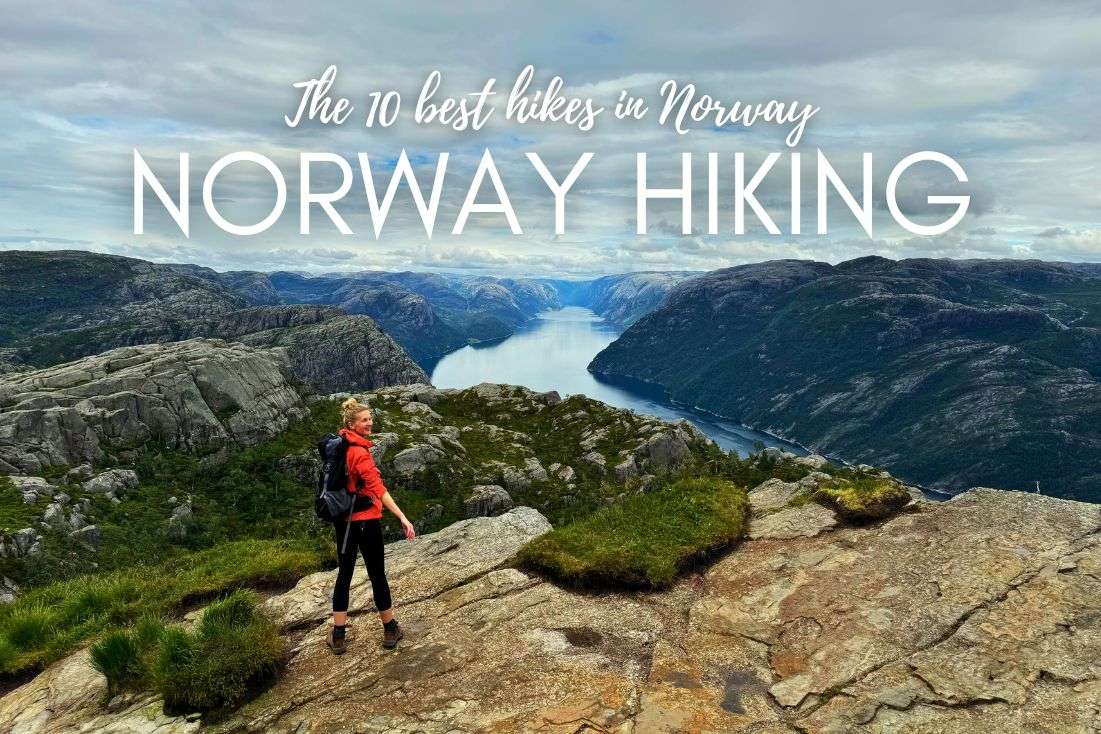



Comments | Thoughts? Give us a shout!